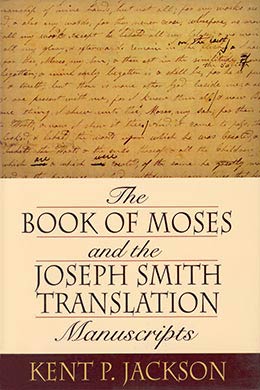History of the Book of Moses
Kent P. Jackson, The Book of Moses and the Joseph Smith Translation Manuscripts (Provo, UT: Religious Studies Center, Brigham Young University, 2005), 1–52.
Selections from the Book of Moses in the Pearl of Great Price is the Joseph Smith Translation (JST) of Genesis 1:1–6:13, the beginning pages of the New Translation. [1] The material in it was revealed between June 1830 and February 1831. In some ways, the Book of Moses [2] can be considered the most significant part of the JST, because it has contributed more distinctive Latter-day Saint doctrine than any other part of that work. It has stood since the beginning of the Church of Jesus Christ of Latter-day Saints as one of the doctrinal cornerstones of the Restoration and as an enduring testimony to the divinely inspired work of Joseph Smith.
We are indebted to Elder Franklin D. Richards of the Quorum of the Twelve Apostles for the existence of the Pearl of Great Price and for including the Book of Moses in it. In 1851, while serving as president of the British Mission in Liverpool, England, he prepared a mission pamphlet containing “a choice selection from the revelations, translations, and narrations of Joseph Smith.” [3] He drew the title, the Pearl of Great Price, from the treasured object in Jesus’s parable in Matthew 13:45–46. Among other important texts of the Restoration, Elder Richards included excerpts of the first chapters of Genesis from Joseph Smith’s Bible translation. [4] Since the 1851 Liverpool publication, other editions of material from the Genesis translation have appeared in print. In 1867 the Reorganized Church of Jesus Christ of Latter Day Saints published what is now commonly called the Inspired Version, an edited transcript of the entire JST. That was followed in 1878 by a new edition of the Pearl of Great Price, published by the Church of Jesus Christ of Latter-day Saints in Salt Lake City, Utah. Revised editions of the Pearl of Great Price, each with changes to the text of the Book of Moses, followed in 1902, 1921, and 1981.
Old Testament Manuscript 1
The JST was recorded in ink on the common writing paper of the Prophet’s day, “foolscap” paper. The name applies to a size of sheets approximately sixteen by thirteen inches in dimension. [5] They were folded in the middle and stitched at the fold, making writing booklets with pages about eight inches wide and thirteen inches tall. The original dictated text of Joseph Smith’s Genesis translation is on a manuscript titled Old Testament Manuscript 1 (OT1). [6] The Book of Moses is found on the first twenty-one pages, in the handwriting of four different scribes:
Pages 1–10 Oliver Cowdery Moses 1:1–5:43 June 1830–?
Pages 10–11 John Whitmer Moses 5:43–6:18 Oct. 21, 1830; Nov. 30, 1830
Pages 11–14 Emma Smith Moses 6:19–52 Dec. 1, 1830
Pages 14–15 John Whitmer Moses 6:52–7:1 Dec. 1830
Pages 15–21 Sidney Rigdon Moses 7:2–8:30 Dec. 1830; Feb. 1831
The work of the JST began either in Harmony, Pennsylvania; Colesville, New York; or Fayette, New York. It continued in Fayette and then in Kirtland, Ohio. The starting month, June 1830, is written on OT1, page 1. Oliver Cowdery, taking dictation from Joseph Smith, wrote the first ten pages. In October he left on the Lamanite Mission that introduced the restored gospel in Ohio and Missouri. [7] He was replaced as scribe by John Whitmer, who wrote the date October 21, 1830, on page 10 and started his first brief service as scribe. Farther down the same page, Whitmer inserted the date November 30, 1830, and wrote more. Emma Smith then wrote slightly more than two pages. She began by writing “Dec 1rst” at the bottom of page 11 and wrote to the top of page 14. The previous July, she had been called in a revelation to write for the Prophet when his regular scribe (at that time Oliver Cowdery) was unavailable (see D&C 25:6). Her work on the JST manuscript was in fulfilment of that calling. John Whitmer resumed scribing again and wrote on two more pages, after which Sidney Rigdon’s handwriting first appears. Rigdon had arrived in Fayette on December 10, 1830, and soon thereafter was appointed by revelation to be Joseph Smith’s scribe (see D&C 35:20). The translation was interrupted when the Prophet prepared to move from New York to Ohio in January 1831. He arrived in Kirtland, Ohio, on about the first of February and soon began anew his work on the New Translation, again with Sidney Rigdon as scribe. It was there that the Book of Moses was finished in February 1831. Rigdon continued as scribe for the rest of OT1, which ends in Genesis 24. He also wrote large portions of the other JST manuscripts, and more than half of the pages of the entire New Translation are in his handwriting.
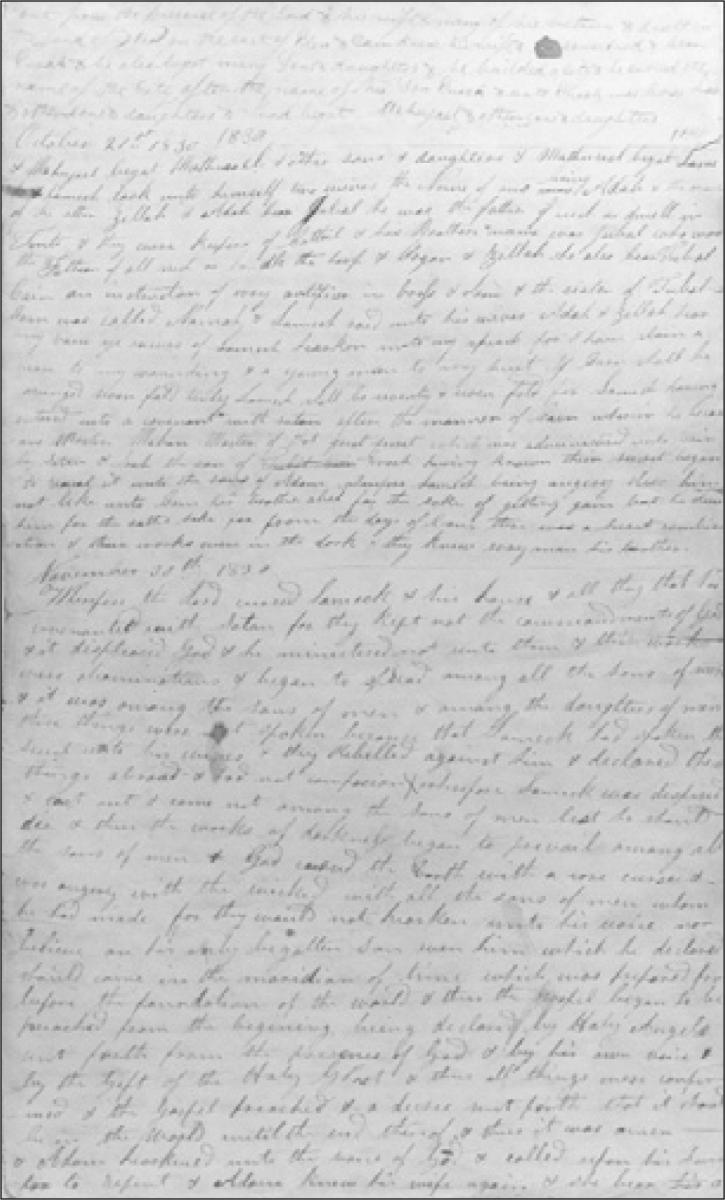 Old Testament Manuscript 1, page 10, showing the dates October 21, 1830, and November 30, 1830; handwriting of Oliver Cowdery (lines 1–5) and John Whitmer; Moses 5:41–6:2
Old Testament Manuscript 1, page 10, showing the dates October 21, 1830, and November 30, 1830; handwriting of Oliver Cowdery (lines 1–5) and John Whitmer; Moses 5:41–6:2
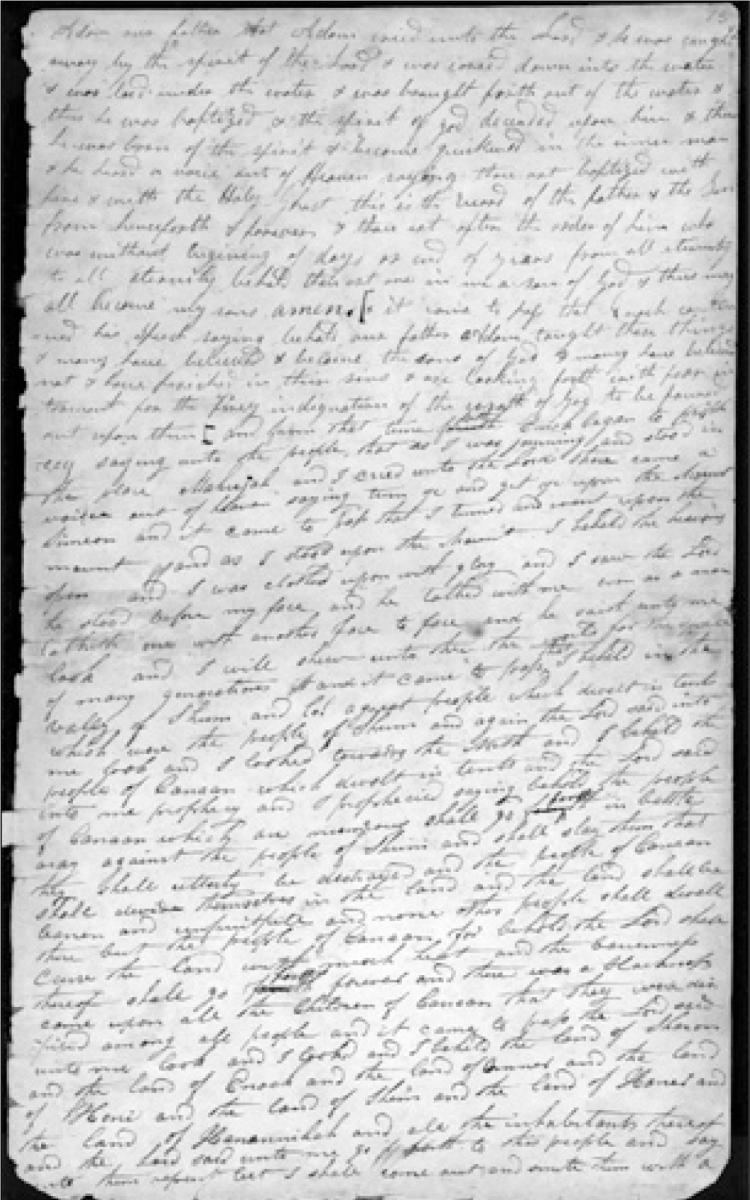 Old Testament Manuscript 1, page 15, December 1830; handwriting of John Whitmer (to bracket on line 16) and Sidney Rigdon; Moses 6:64–7:10
Old Testament Manuscript 1, page 15, December 1830; handwriting of John Whitmer (to bracket on line 16) and Sidney Rigdon; Moses 6:64–7:10
In general, Joseph Smith’s scribes wrote without using punctuation, which sometimes makes it difficult to interpret the intended meaning of his words. Some of the other JST manuscripts were punctuated heavily by later hands, but that is not the case with OT1.
By April 5, 1831, a duplicate of OT1 had been made, called Old Testament Manuscript 2 (OT2). Although it started as a copy of the dictated manuscript, OT2 later became the document on which the Prophet continued his translation to the end of the Old Testament. But additional corrections were also made on OT1. Sometime after Oliver Cowdery returned from the Lamanite Mission in summer 1831, Joseph Smith apparently dictated to him some revisions to what he had translated already. Oliver Cowdery recorded those changes on OT1. [8] But OT2 had been written prior to that date, and thus those changes were never recorded on the new manuscript. As a result, they were later overlooked, and they have never been put in place in the Book of Moses. Similarly, six small changes, apparently in the handwriting of Joseph Smith, were inserted in OT1 sometime after the original dictation. [9]
The text of OT1 is one of the most significant documents of the restored gospel. In its doctrinal contributions it is on par with the greatest of revelations. But OT1 is not the complete and final text of the Book of Moses, because that is found on OT2, on which Joseph Smith made further inspired corrections and additions.
Old Testament Manuscript 2
Old Testament Manuscript 2 (OT2) began as a transcription—a duplicate copy—of OT1. [10] It was created by John Whitmer, who was called in a revelation of March 8, 1831, to assist Joseph Smith “in transcribing all things which shall be given” to him (D&C 47:1). Whitmer probably began copying OT1 shortly after the revelation was received. The date he finished the work is written at the end of OT1: “April 5th 1831 transcribed thus far.” [11] The Book of Moses is found on the first twenty-seven pages of OT2, and probably all of it was copied during the month of March 1831. That same month, Joseph Smith interrupted his Old Testament translation at Genesis 24 to work on the New Testament as he had been instructed in a revelation (see D&C 45:60–61). When the New Testament was finished in July 1832, he returned to finish the Old Testament. But when he did, he used OT2 rather than OT1 as the working document. It was on OT2 that he continued his translation to the end of Malachi, which he finished in July 1833. [12] And it was on OT2 that he made additional revisions to the work in Genesis that he had already translated. When it was completed, OT2 was 119 pages long.
Unlike OT1, which was an original dictation and contains very few later changes, OT2 shows signs of subsequent correcting, editing, and emending. In the Book of Moses section (pages 1–27), some editing was done to correct copying errors or errors made when the Prophet was dictating from his Bible and his eyes skipped from one line to the next, resulting in omitted material. The manuscript shows that John Whitmer made corrections to his own copying, and Sidney Rigdon made corrections when he compared the transcription to corresponding Bible passages. [13] OT2 contains verse divisions and verse numbers that were inserted by Joseph Smith’s clerks, as well as punctuation and capitalization changes that were made by unknown hands.
The most important changes made after the original transcription were those that were inserted by Joseph Smith. Sometime after Genesis of OT2 was written, the Prophet revisited the manuscript to make further revisions. Some of those are editorial in nature and clarify and smooth out the words of the dictated text. But others are inspired additions and corrections that provide new insights or even change the meaning of what had been written before. Sidney Rigdon was the scribe for all but a very few of the corrections, recording the words dictated by the Prophet. We do not know when the additional corrections were made. As far as we know, Sidney Rigdon served as Joseph Smith’s scribe only until fall 1833, and thus it is likely that the changes were made before then, perhaps even while the original dictation of other parts of the Bible was still under way.
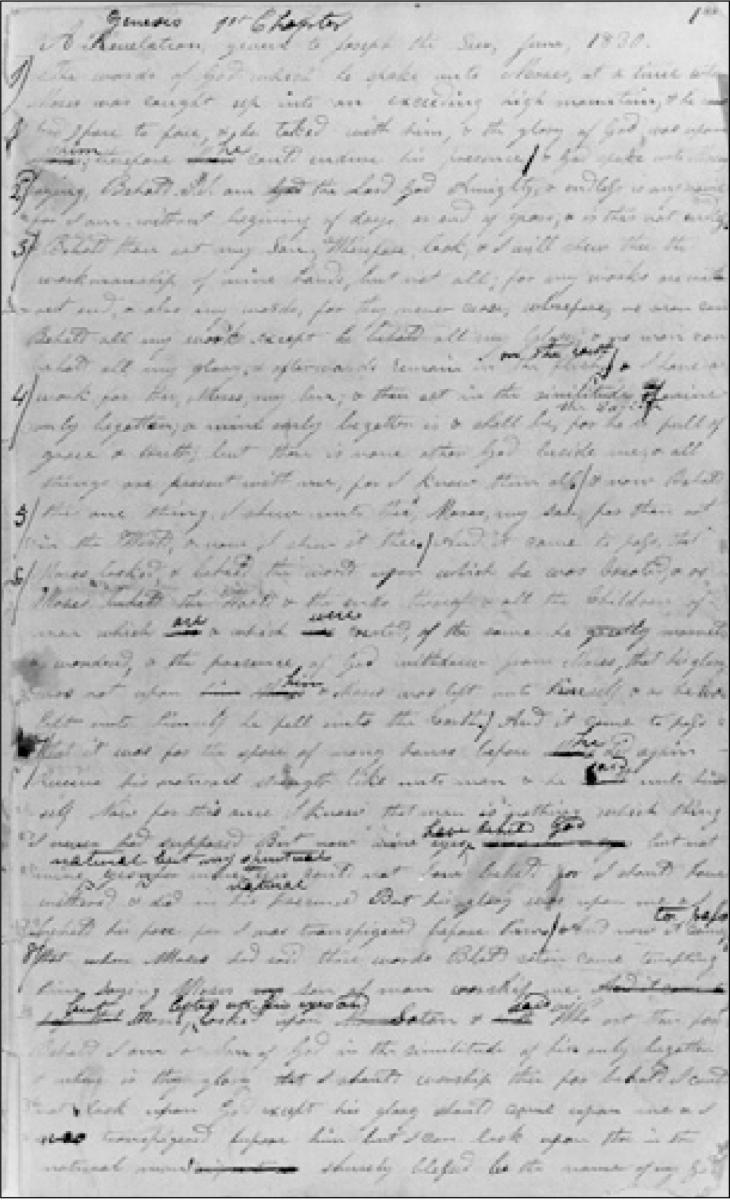 Old Testament Manuscript 2, page 1, copied from Old Testament Manuscript 1, page 1, March 1831; handwriting of John Whitmer, corrections by Sidney Rigdon; Moses 1:1–15
Old Testament Manuscript 2, page 1, copied from Old Testament Manuscript 1, page 1, March 1831; handwriting of John Whitmer, corrections by Sidney Rigdon; Moses 1:1–15
OT2 is an extraordinarily important document, containing as it does Joseph Smith’s text of the Book of Moses with his latest corrections. It alone is not sufficient, however. When John Whitmer transcribed from OT1 to OT2, he worked carefully and conscientiously. But he did not produce an error-free text. The manuscript shows that he made numerous word changes as he transcribed, averaging about four and one-half changes per page. Some of the changes were reversed in later editions, but many have persisted to the present. About two-thirds of Whitmer’s word changes appear to have been made intentionally.
Whitmer made grammatical corrections, such as these examples: [14]
OT1: These words was spoken (Moses 1:42)
OT2: These words were spoken
OT1: all things has its likeness (Moses 6:63)
OT2: all things have their likeness
OT1: there was no poor among them (Moses 7:18)
OT2: there were no poor among them
OT1: Zion hath I blessed (Moses 7:20)
OT2: Zion have I blessed
OT1: the saints arose and was crowned (Moses 7:56)
OT2: the saints arose and were crowned
In some changes, Whitmer altered what he apparently believed were errors in the original text, as these examples illustrate:
OT1: thou art in similitude (Moses 1:6)
OT2: thou art in the similitude
OT1: I am with you even to the end of thy days (Moses 1:26)
OT2: I am with thee even unto the end of thy days
OT1: the waters (Moses 2:2, 6)
OT2: the water
OT1: which bore record of the Father and the Son (Moses 5:9)
OT2: which beareth record of the Father and the Son
OT1: in the likeness of God made he him (Moses 6:8)
OT2: in the likeness of God created he him
OT1: I will give thee utterance (Moses 6:32)
OT2: and I will give thee utterance
OT1: could not stand before his presence (Moses 6:47)
OT2: could not stand in his presence
OT1: out of the depths of the sea (Moses 7:14, twice)
OT2: out of the depth of the sea
OT1: Messiah (Moses 7:53, twice)
OT2: the Messiah
In some cases Whitmer made word changes that go well beyond what the Prophet dictated, as in these examples:
OT1: if thou doest well shalt thou not be accepted? (Moses 5:23)
OT2: if thou doest well thou shalt be accepted
OT1: things which were not visible (Moses 6:36)
OT2: things which were not visible to the natural eye
OT1: millions of earths like this (Moses 7:30)
OT2: millions of such earths like this
OT1: Noah called upon men (Moses 8:20)
OT2: Noah called upon the children of men
About a third of the differences between OT1 and Whitmer’s copy of it on OT2 appear to be unintended transcribing errors, as in these examples:
OT1: the immortality and the eternal life of man (Moses 1:39)
OT2: the immortality and eternal life of man
OT1: and the light was good (Moses 2:4)
OT2: and that light was good
OT1: he thought to destroy the world (Moses 4:6)
OT2: he sought to destroy the world
OT1: by the sweat of thy face (Moses 4:25)
OT2: in the sweat of thy face
OT1: I have forgiven thee thy transgressions (Moses 6:53)
OT2: I have forgiven thee thy transgression
OT1: And great tribulations (Moses 7:61)
OT2: A great tribulation
OT1: sweep the earth as with the flood (Moses 7:62)
OT2: sweep the earth as the flood
OT1: and ye shall receive the gift of the Holy Ghost (Moses 8:24)
OT2: and ye shall receive the Holy Ghost
OT1: and if you do not do this (Moses 8:24)
OT2: and if you do not this
There are about one and one-half of these apparent scribal errors per manuscript page. While some of them were discovered and corrected by later editors, some are still in the Book of Moses today.
OT1 and OT2 are the original manuscripts of the Book of Moses. Of these, OT2 is the most significant, containing the final product of Joseph Smith’s revealed text. Aside from the imperfections that it contains as a result of transcription errors and grammatical and spelling anomalies, OT2 is the text of the Book of Moses as Joseph Smith intended it and as he left it to the Church. As far as we know, the Prophet kept these original manuscripts in his possession throughout this life. He looked forward to the day in which the entire New Translation would be published, [15] and the manuscripts were among his private property when he died.
Early Manuscripts and Printings
During Joseph Smith’s lifetime, parts of his New Translation of the Bible were copied by hand, and some copies may have circulated among interested Church members. Today we know of only a few early extant copies. The earliest was made by John Whitmer, probably in January 1831. It includes the first five chapters of Genesis (Moses 1:1–8:12), rather hastily copied from the first twenty pages of OT1. [16] Edward Partridge made a copy of OT1 in about February 1831 in Kirtland, Ohio, not long after Joseph Smith and his scribe Sidney Rigdon arrived there. The surviving pages of the Partridge manuscript contain only Genesis 5:19–9:12 (including Moses 6:21–8:30). [17]
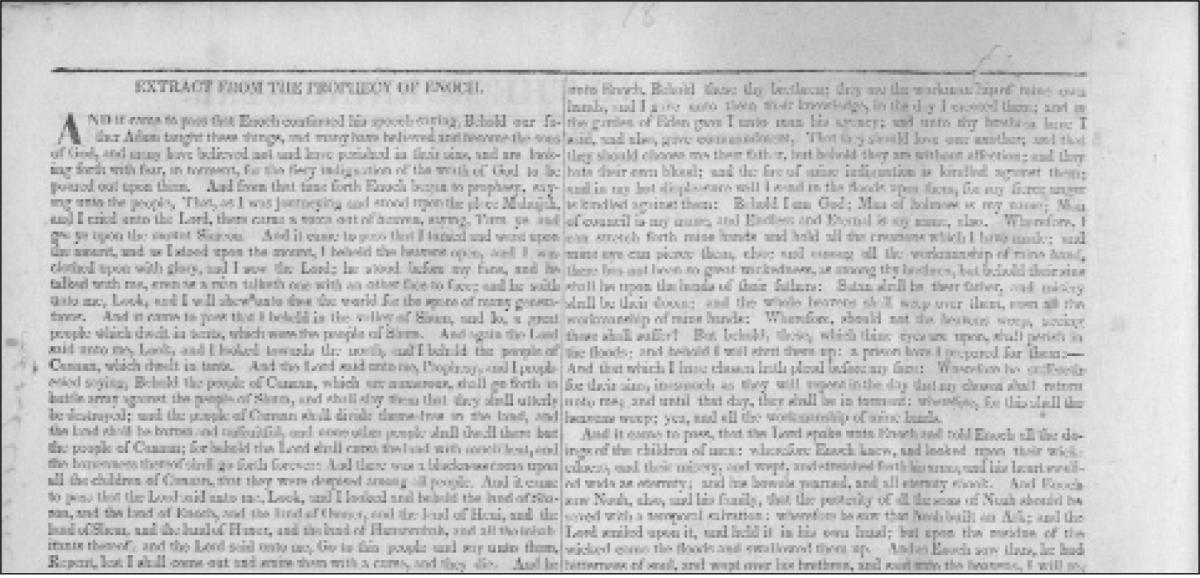 "Extract from the Prophecy of Enoch," The Evening and the Morning Star, August 1832, page 2 (top of page), Independence Missouri; first publication of an excerpt from the New Testament; Moses 7:1-11, 32-44
"Extract from the Prophecy of Enoch," The Evening and the Morning Star, August 1832, page 2 (top of page), Independence Missouri; first publication of an excerpt from the New Testament; Moses 7:1-11, 32-44
The earliest printing of Book of Moses material took place in August 1832, when Moses 7 was printed in its entirety in the Church’s Independence, Missouri, newspaper, The Evening and the Morning Star (EMS). [18] In March 1833, Moses 6:43–68 was printed in the same newspaper, [19] and Moses 5:1–16 and 8:13–30 appeared the following month. [20] When the Lectures on Faith (LF) were printed in the Doctrine and Covenants in 1835, some passages from the New Translation were used in the second lecture, including several verses from Genesis. [21] All of those early publications of Book of Moses material—both in The Evening and the Morning Star and in the Lectures on Faith—were based on the text of OT1, as a careful comparison reveals. Thus they do not contain the Prophet’s latest corrections and insertions. Nothing more was printed from the Book of Moses until early in 1843, when a chapter appeared in the Church’s Nauvoo, Illinois, newspaper, the Times and Seasons (TS). In January of that year, an installment in the serial publication of Joseph Smith’s history included the full text of Moses 1. [22] That text is unique among the early publications. It was not based on OT1 but on a copy that someone had made, about a decade earlier, of OT2 prior to the insertion of Joseph Smith’s corrections. Thus it includes some of the unique characteristics of John Whitmer’s transcription. Like the earlier publications from The Evening and the Morning Star and the Lectures on Faith, this publication was not always carefully done and not always identical to the text on the original manuscripts. In several places, editors or typesetters changed words in these early printings, often for reasons that are not apparent now. Among other changes, the Lectures on Faith remove the first-person voice from the Creation account and modernize much of the language of the text. The archaic pronouns thou and ye are modernized to “you.” Following are some examples of divergences from the original manuscripts:
OT2: for this once I know (Moses 1:10)
TS: for this cause I know
OT1: transfigured before him (Moses 1:14)
TS: strengthened before him
OT2: and wrent upon the earth (Moses 1:19)
TS: and went upon the earth
OT1, OT2: departed hence, yea from the presence of Moses (Moses 1:22)
TS: departed hence, even from the presence of Moses
OT1, OT2: and numberless are they unto man (Moses 1:35)
TS: and innumerable are they unto man
OT1: and said unto him, Where goest thou? And he said, I heard thy voice (Moses 4:15–16)
LF: and said unto him, Where are you going? And he said, I heard your voice
OT1, OT2: and stood in the place Mahujah (Moses 7:2)
EMS: and stood upon the place Mahujah
OT2: the powers of Satan were upon all the face of the earth (Moses 7:24)
EMS: the power of Satan was upon all the face of the earth
OT1, OT2: And whoso cometh in at the gate (Moses 7:53)
EMS: Whoso cometh in at the gate
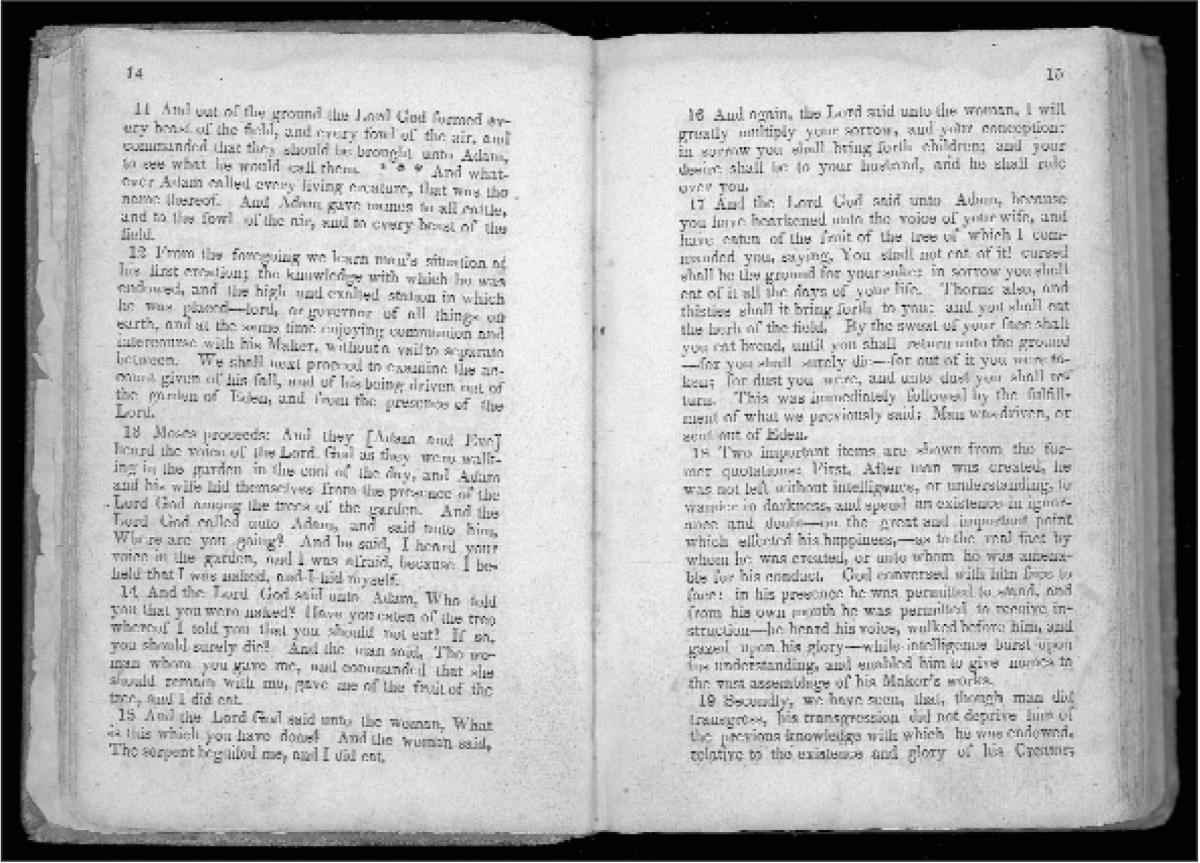 Lectures of Faith, Lecture 2. 1835 Doctrine and Covenants, pages 14-15, showing Joseph Smith Translation language in modernized form.
Lectures of Faith, Lecture 2. 1835 Doctrine and Covenants, pages 14-15, showing Joseph Smith Translation language in modernized form.
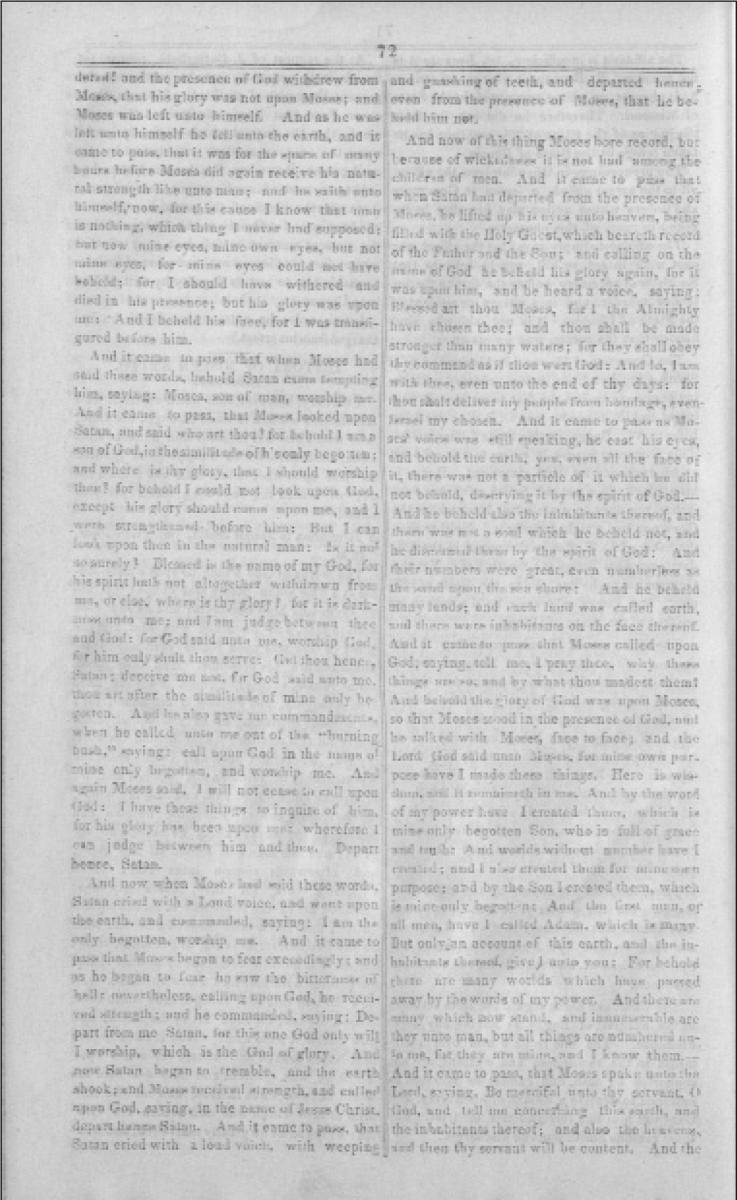 "History of Joseph Smith," Times and Seasons, January 16, 1843, page 72, Nauvoo, Illinois; Moses 1:8-37.
"History of Joseph Smith," Times and Seasons, January 16, 1843, page 72, Nauvoo, Illinois; Moses 1:8-37.
After the Prophet’s death, another significant manuscript copy was made. In summer 1845, John M. Bernhisel, a trusted friend of Joseph and Emma Smith, was given permission by the Prophet’s widow to borrow the Joseph Smith Translation manuscripts and to study and copy them. While he had the documents in his possession, he made a copy that includes parts of the Old and New Testaments. The Old Testament material was copied from OT2. Although the Bernhisel manuscript is incomplete and not always an accurate reproduction of the original, it is an important document because it reflects the state of the New Translation shortly after Joseph Smith’s death. [23]
The 1851 Pearl of Great Price
In 1851 Elder Franklin D. Richards created what we now call the Book of Moses by publishing Genesis excerpts from the Joseph Smith Translation in his British Mission pamphlet, the Pearl of Great Price. His excerpts were presented in two parts at the beginning of the pamphlet. The first was “Extracts from the prophecy of Enoch, containing also a revelation of the gospel unto our father Adam, after he was driven out from the Garden of Eden.” It included part of Moses 6 and all of Moses 7. [24] The second part was called “The words of God, which he spake unto Moses at the time when Moses was caught up into an exceeding high mountain, and he saw God face to face, and he talked with him, and the glory of God was upon Moses; therefore Moses could endure his presence.” That section included all of chapters 1–3 and parts of chapters 4, 5, and 8. [25] Altogether, the 1851 Pearl of Great Price contained Moses 1:1–4:19, 22–25; 5:1–16, 19–23, 32–40; 6:43–7:69; 8:13–30. Not included were sizable portions of chapters 4, 5, 6, and 8. Most of the Book of Moses material in the 1851 Pearl of Great Price had been published years earlier in The Evening and the Morning Star, the Lectures on Faith, and the Times and Seasons. Those appear to have been sources that Elder Richards used for his publication. Yet some of the material had never been printed before. Because Elder Richards had no access to original documents, it follows that he must have had handwritten copies of earlier manuscripts that contributed as sources for parts of his publication. All of his printed sources were based on OT1, except for Moses 1, which was based on OT2 before it received the Prophet’s later revisions, as noted above. His manuscript sources show affinities both to OT1 and to OT2 before it was finished. The passages included in the 1851 Pearl of Great Price were not copied with perfect accuracy, and changes were introduced into the text at a few places. Thus the 1851 Book of Moses was not always correctly transcribed, nor did it contain Joseph Smith’s best text of the record of Moses.
At the same time the Pearl of Great Price was being prepared, Elder Richards published part of the Book of Moses material (Moses 2:1–4:13) in the British Mission periodical, the Millennial Star, of which he was the editor. [26] That material is the same as the corresponding passages that were published a few months later in the Pearl of Great Price.
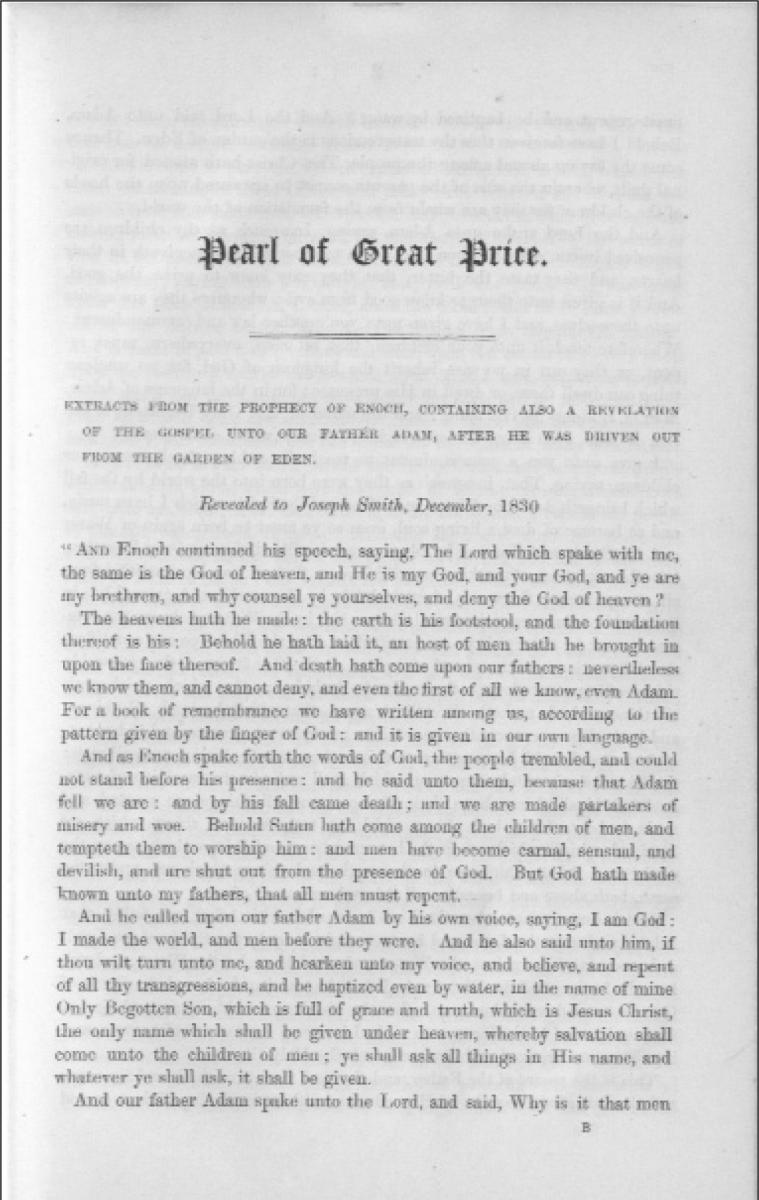 “Extracts from the Prophecy of Enoch,” Pearl of Great Price, 1851, Liverpool, England, page 1; Moses 6:43–53
“Extracts from the Prophecy of Enoch,” Pearl of Great Price, 1851, Liverpool, England, page 1; Moses 6:43–53
Despite its incompleteness and imperfections, the 1851 Book of Moses was a tremendous blessing for the Church. Very few Latter-day Saints then had access to the New Translation printings from the newspapers of the 1830s and 1840s. Elder Richards’s Pearl of Great Price brought thousands of Latter-day Saints into contact with great revelations to Joseph Smith of which most Church members were entirely unaware. It introduced generations to an important part of the Restoration and developed in them a greater love for the Prophet and his work. It went far to fulfill the wish that Elder Richards expressed in his preface, that “sinners, as well as Saints, will know that JOSEPH SMITH was one of the greatest men that ever lived upon the earth, and that under God he was the Prophet and founder of the dispensation of the fulness of times, in which will be gathered together into one all things which are in Christ, both which are in heaven and which are on earth.” [27]
The 1866–67 RLDS Committee Manuscript
At the April 1866 conference of the Reorganized Church of Jesus Christ of Latter Day Saints, the decision was made to publish Joseph Smith’s New Translation of the Bible. In less than two years, the efforts of preparing the text, setting the type, stereotyping printing plates, and printing and binding the signatures bore fruit. In December 1867 the edited transcription of Joseph Smith’s entire Bible revision was published in Bible format, titled The Holy Scriptures.[28] This publication is still in print today, with its most recent edition having come out in 1991. Since the nineteenth century, it has been popularly called the Inspired Version, a name that was added officially to the title page in 1936.[29]
To prepare the Bible publication, the original JST manuscripts were first obtained from Emma Smith Bidamon, the Prophet’s widow, who had preserved them in her possession since Joseph Smith’s death in 1844. In order to protect the original manuscripts and facilitate the publication, church leaders determined that a printer’s copy would be transcribed. At the April conference it was resolved “That the Manuscript of the Scriptures, be engrossed, and the engrossed copy be put into the hands of the printer, with a view to the preservation of the original copy.”[30] To engross means to make a copy, in this case a copy that could be edited and prepared for publication. Marietta H. Faulconer and Mark H. Forscutt were employed to make the transcription. Faulconer copied the text from Genesis 1 through Psalms; Forscutt finished the work to the end of the New Testament. The manuscript they produced is called the Committee Manuscript (CM).[31] The Book of Moses material is found on its first fifty-nine pages, transcribed by Marietta Faulconer.[32]
When one examines the RLDS Committee Manuscript carefully, one can determine the history of its preparation. That history has heretofore not been well understood, but it is important for Latter-day Saints because today’s Book of Moses—indeed, every edition of the Book of Moses since 1878—uses the text that was established in the 1866–67 RLDS Committee Manuscript, with some variations. The writing on the manuscript reveals that the document was produced in three stages.
First, Marietta Faulconer began the Committee Manuscript by transcribing OT1, assuming incorrectly that it was the document that contained the Prophet’s intended text. It is evident that at that time she, and perhaps RLDS officials as well, did not understand that OT1 had been superceded by the later manuscript OT2, on which Joseph Smith had made additional corrections. OT1 lacked not only the grammatical and literary refinements that the Prophet had inserted into the text, but it also lacked his later content changes, rewordings, and additions. It is clear that Faulconer’s intent was to copy faithfully from the original without editing, except to correct spelling. For the most part she succeeded, even reproducing obvious grammatical errors. But at the same time, her eyes frequently skipped words on the page, omitting text. Either consciously or accidentally, she also made a few small word changes, as these examples show:
OT1: by the sweat of the brow (Moses 5:1)
CM: by the sweat of his brow
OT1: And in these days (Moses 6:15)
CM: And in those days
OT1: there was a blackness come (Moses 7:8)
CM: there was a blackness came
OT1: and all the creation of God mourned (Moses 7:56)
CM: and all the creations of God mourned
The positive result of Faulconer’s decision to copy OT1 was that she did not copy onto the Committee Manuscript the scribal errors and anomalies that John Whitmer had added in OT2.
In the second stage of the preparation of the Committee Manuscript, Joseph Smith III proofed and corrected Faulconer’s transcription against OT2. The Prophet’s son and president of the RLDS Church was the chair of the committee that oversaw the publication of the Inspired Version. In his autobiography he reports that he went through Faulconer’s transcription and edited it before sending it on to its production.[33] The Committee Manuscript itself attests to his work, showing his handwriting in many places. Because Faulconer’s eyes had skipped text so frequently, President Smith’s edit was indispensable. It is clear that he realized that Faulconer had copied the wrong text, but rather than discarding her transcription and starting a new one from the proper original, he decided to correct her writing on the manuscript by editing it against OT2. He changed words to match those in OT2 and added the insertions between the lines as they appeared on OT2. In doing so he restored his father’s corrections to the text. Unfortunately, this process deleted the corrections that the Prophet had made to OT1 that were never transcribed onto OT2. Joseph Smith III deleted those OT1 insertions and replaced them with the uncorrected text from OT2. As a result, they were not included in the Inspired Version, and they have never been in the Pearl of Great Price. President Smith’s work was done very carefully and very accurately, but while he restored the passages that Faulconer had inadvertently omitted, he also copied onto the Committee Manuscript some of the errors that John Whitmer had made in OT2. And he also made a very few small transcription errors of his own, including this one:
OT2: coats of skin (Moses 4:27)
CM: coats of skins
Because Joseph Smith III was preparing the text for publication, in a few places he corrected grammatical problems, as these examples show:[34]
OT2: he had drew away many after him (Moses 4:6)
CM: he had drawn away many after him
OT2: were it not for our transgression we should never had seed, and should never had known good and evil (Moses 5:11)
CM: were it not for our transgression, we never should have had seed, and never should have known good and evil
OT2: saying unto the tent keepers, tarry thou here (Moses 6:38)
CM: saying unto the tent keepers, tarry ye here
OT2: no man laid their hands on him (Moses 6:39)
CM: no man laid hands on him
In some places he edited the wording apparently to correct the style:
OT2: and his wife and many of his brethren and dwelt (Moses 5:41)
CM: and with his wife and many of his brethren dwelt
OT2: even him who he declared should come (Moses 5:57)
CM: even him whom he declared should come
OT2: they were of one heart, and of one mind (Moses 7:18)
CM: they were of one heart, and one mind
OT2: how is it the heavens weep (Moses 7:28)
CM: how is it that the heavens weep
The third stage in the production of the Committee Manuscript text is also in evidence on the pages. After Joseph Smith III had corrected Faulconer’s transcription to make it consistent with the Prophet’s final text, he returned to the Committee Manuscript and deleted many of Joseph Smith’s corrections. The manuscript shows that he lined out many of the insertions that Joseph Smith had dictated to his scribes and replaced them with the earlier readings. This happened especially in chapters 1 and 7. In those chapters, the general rule seems to be that he left his father’s changes that corrected the grammar or clarified the wording but deleted those that changed the meaning of the text or added new insights. The consequence was that his editing reverted many OT2 readings back to those found in OT1, thereby overruling much of his father’s work on the text. Many examples can be shown of Joseph Smith’s corrections, large and small, that were excluded in this way from the 1867 Inspired Version and thus never have been included in the Pearl of Great Price. The following OT2 passages represent Joseph Smith’s text, and the CM passages show what was finalized on the Committee Manuscript and passed on in the Inspired Version and the Book of Moses:
OT2: But Moses lifted up his eyes and looked upon Satan (Moses 1:13)
CM: And it came to pass that Moses looked upon Satan
OT2: they shall obey thy command even as my commandments (Moses 1:25)
CM: they shall obey thy command even as if thou wert God
OT2: called upon God, saying, Show me . . . and by whom thou madest them (Moses 1:30)
CM: called upon God, saying, Tell me . . . and by what thou madest them
OT2: And the Lord God spake unto Moses of the heavens, saying, These are many (Moses 1:37)
CM: And the Lord God spake unto Moses, saying, The heavens, there are many
OT2: the record of heaven, the Comforter, the keys of the kingdom of heaven (Moses 6:61)
CM: the record of heaven, the Comforter, the peaceable things of immortal glory
OT2: he had a great chain in his hand, and he veiled the whole face of the earth (Moses 7:26)
CM: he had a great chain in his hand, and it veiled the whole face of the earth
OT2: Enoch looked upon the residue of the people and wept. And he beheld and lo, the heavens wept also and shed forth their tears (Moses 7:28)
CM: the God of heaven looked upon the residue of the people, and wept; and Enoch bore record of it, saying, How is it that the heavens weep and shed forth their tears . . . ?
OT2: and thy presence is there (Moses 7:30)
CM: and thy bosom is there
OT2: I gave unto them their intelligence (Moses 7:32)
CM: I gave unto them their knowledge in the day that I created them
OT2: And in the Garden of Eden, man had agency (Moses 7:32)
CM: And in the Garden of Eden, gave I unto man his agency
OT2: and that they should serve me their God (Moses 7:33)
CM: and that they should choose me their Father
OT2: Satan shall be their master (Moses 7:37)
CM: Satan shall be their father
OT2: And he whom I have chosen (Moses 7:39)
CM: And that which I have chosen
OT2: stretched forth his arms, and he beheld eternity (Moses 7:41)
CM: stretched forth his arms, and his heart swelled wide as eternity
OT2: in the name of thine Only Begotten (Moses 7:50)
CM: in the name of thine Only Begotten, even Jesus Christ
OT2: that from a remnant of his seed should come all nations (Moses 7:52)
CM: that a remnant of his seed should always be found among all nations
When one compares the editing on the RLDS Committee Manuscript with the earliest publications of New Translation material, one can see the origin of the changes that Joseph Smith III made. After preparing the Committee Manuscript to match OT2, he decided to check it against the texts as they were published in The Evening and the Morning Star in 1832–33 and the Times and Seasons in 1843. His revisions on the manuscript proof it against those publications and change its words to match theirs. One evidence for this is the fact that idiosyncratic readings in those newspapers that are not based either on OT1 or on OT2 are inserted and reproduced faithfully in the Committee Manuscript, as in these examples:
OT1: in the natural man, if not so surely blessed be (Moses 1:14–15)
OT2: in the natural man! surely blessed be
TS, CM: in the natural man: Is it not so surely? Blessed is
OT1, OT2: for it is blackness unto me (Moses 1:15)
TS, CM: for it is darkness unto me
OT1, OT2: and by the same I created them (Moses 1:33)
TS, CM: and by the Son I created them
OT1, OT2: And Enoch said unto the heavens (Moses 7:29)
EMS, CM: And Enoch said unto the Lord
Why Joseph Smith III made these changes in the New Translation text is not known. He apparently felt that the chapters as published in The Evening and the Morning Star and the Times and Seasons were superior to what was written on OT2. This misunderstanding is very significant. Not only does the printed Inspired Version not reflect accurately the text of Genesis as Joseph Smith prepared it, but the same is also true of every edition of the Book of Moses since 1878, because the 1878 Book of Moses was taken directly from the 1867 Inspired Version.
Joseph Smith’s scribes used inconsistent capitalization and very little punctuation as they wrote. Unidentified hands inserted punctuation and corrected capitalization in OT2, but we do not know when those processes took place. The verse numbers in OT2 were inserted by the Prophet’s scribes or clerks.[35] The punctuation on the Committee Manuscript appears to have been inserted after the transcription. It tends to be rather heavy and often obscures the flow of the text. The Committee Manuscript’s verse divisions were added after the transcription as well. They rarely follow those that were inserted in OT2 by Joseph Smith’s assistants.
On the OT2 manuscript, a very few isolated words are written, usually in pencil, that are not in the handwriting of Joseph Smith’s known scribes. The insertions identify obvious grammatical errors[36] or errors made in the transcription process that others did not notice.[37] They appear to have been written by Joseph Smith III, who perhaps penciled them in while he was working on the Committee Manuscript in 1867 or later.
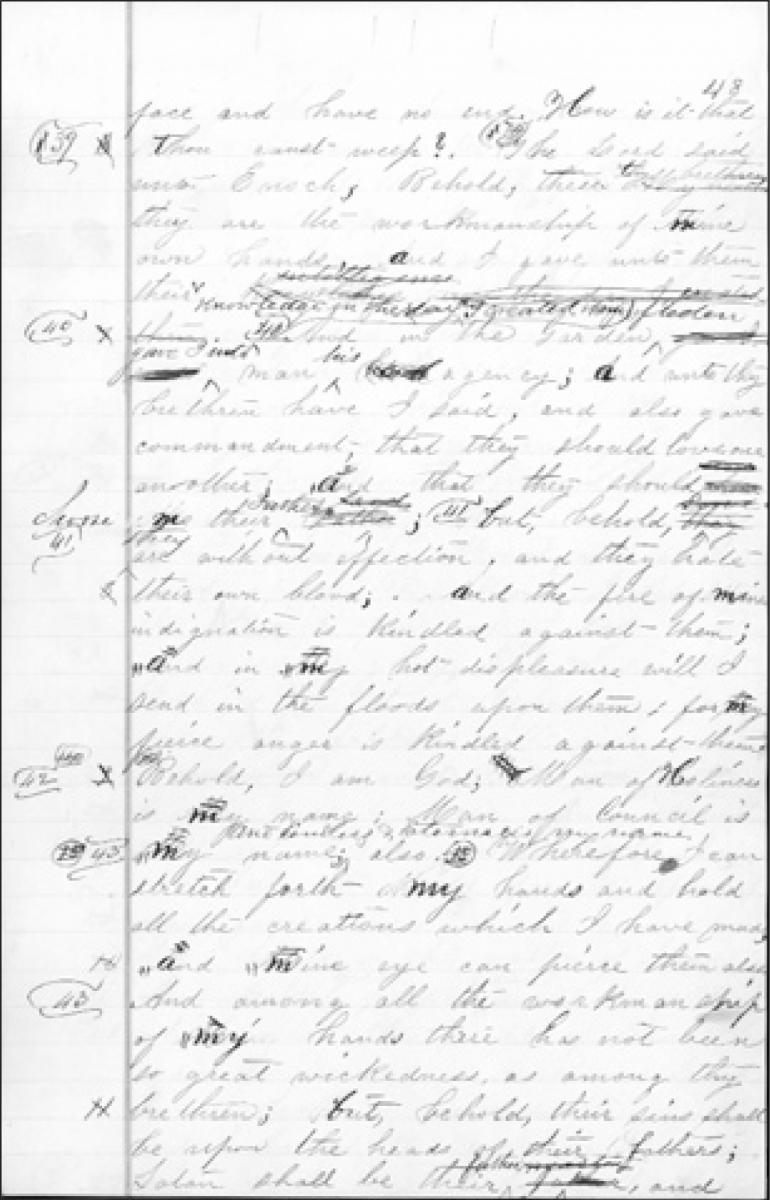 Committee Manuscript, Reorganized Church of Jesus Christ of Latter Day Saints, 1866–67, page 48; handwriting of Marietta H. Faulconer, corrections by Joseph Smith III; Moses 7:31–37
Committee Manuscript, Reorganized Church of Jesus Christ of Latter Day Saints, 1866–67, page 48; handwriting of Marietta H. Faulconer, corrections by Joseph Smith III; Moses 7:31–37
The 1867 Inspired Version
The 1867 Inspired Version (IV ) is an edited, printed transcription of the entire Joseph Smith Translation of the Bible. It was typeset not from Joseph Smith’s original manuscripts but from the RLDS Committee Manuscript. Joseph Smith III oversaw the project and took it seriously as a sacred duty.[38]
In the Book of Moses material in the Inspired Version (“A Revelation, Given to Joseph the Seer, June, A.D. 1830” and Genesis 1:1–8:18), the text differs in some instances from what was written on the Committee Manuscript. It is impossible to tell whether the changes were made by the typesetters or by the publication committee in proofs. Some of the changes appear to be the result of conscious editing, for reasons that are not always clear, but some changes are probably accidental. Following are examples of changes:
OT2: in the name of his Son (Moses 1:21)
CM: in the name of Jesus Christ
IV: in the name of the Only Begotten
OT1, OT2, CM: in the day that thou eatest thereof (Moses 3:17)
IV: in the day thou eatest thereof
OT1, OT2, CM: gave unto them commandment (Moses 5:5)
IV: gave unto them commandments
OT1, CM: I have forgiven thee thy transgressions in the Garden of Eden (Moses 6:53)
IV: I have forgiven thee thy transgression in the Garden of Eden
OT1, OT2, CM: that ye may be sanctified from all sin (Moses 6:59)
IV: that ye might be sanctified from all sin
OT2, CM: and there were no poor among them (Moses 7:18)
IV: and there was no poor among them
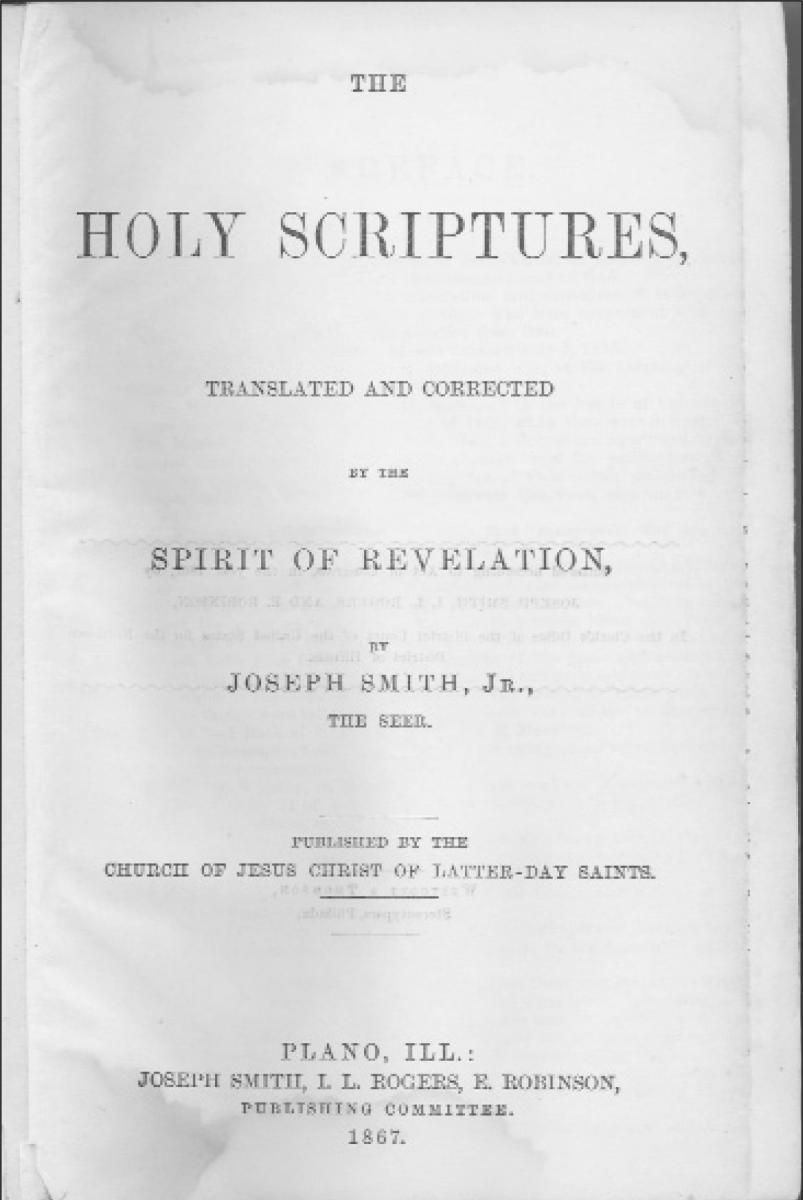 Title page, 1867 Inspired Version, Plano, Illinois
Title page, 1867 Inspired Version, Plano, Illinois
 “A Revelation, Given to Joseph the Seer, June, A.D. 1830,” 1867 Inspired Version, page 7; Moses 1:1–17
“A Revelation, Given to Joseph the Seer, June, A.D. 1830,” 1867 Inspired Version, page 7; Moses 1:1–17
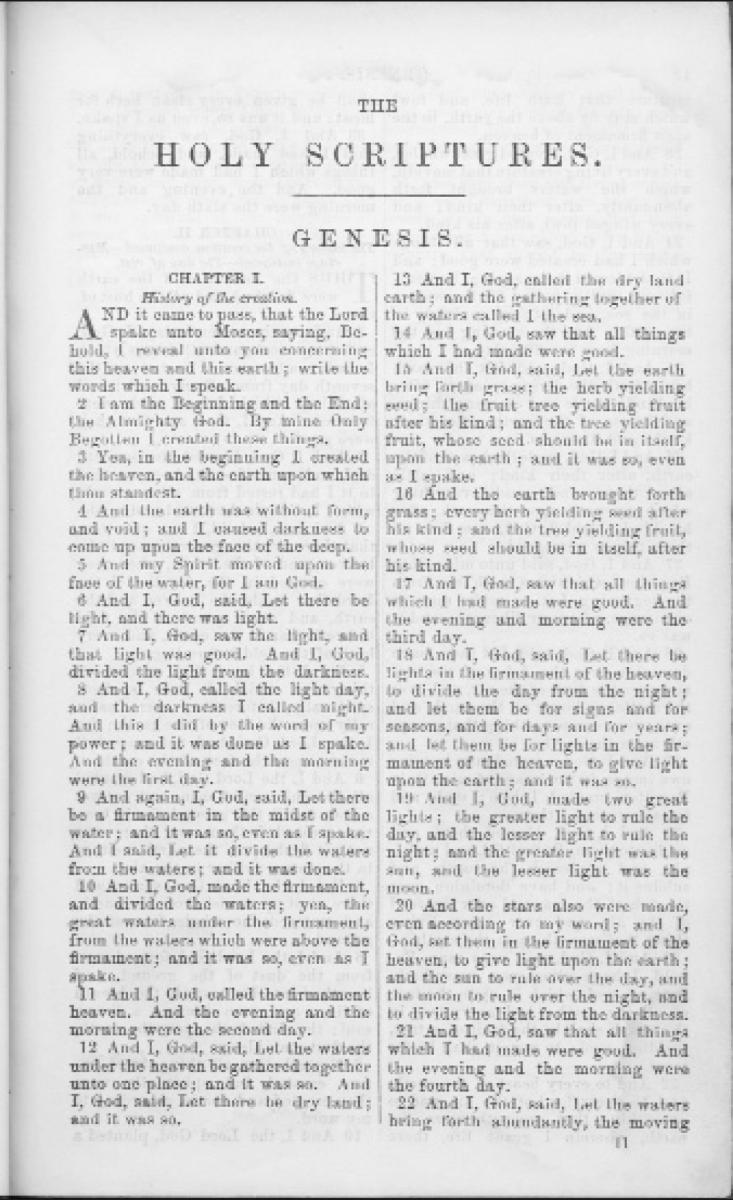 Genesis chapter 1, 1867 Inspired Version, page 11; Moses 2:1–20
Genesis chapter 1, 1867 Inspired Version, page 11; Moses 2:1–20
The 1867 Inspired Version was stereotyped—cast on metal plates that could be used to reprint the book almost indefinitely. The 1867 plates continued to be used until a new printing in 1936, which apparently was the 1867 text unchanged but in an enlarged format. That printing was the first to incorporate officially the name Inspired Version. The first new edition of the text since 1867 was the “New Corrected Edition” of 1944. Its text was checked against the early manuscripts, providing a more accurate transcription than its predecessor, with corrections in over three hundred verses.[39] A subsequent new edition appeared in 1991. It contains some small corrections,[40] but its most interesting feature for Latter-day Saints is its removal of Moses 1. Since 1867, “A Revelation, Given to Joseph the Seer, June, A.D. 1830” (Moses 1) had been included in the Inspired Version as a separate document before Genesis 1. Since 1864 it had also been published in the RLDS Doctrine and Covenants as section 22.[41] As it was available there, in 1991 it was dropped from the Inspired Version.[42]
The 1878 Pearl of Great Price
Desiring to make universally available the important revelations that were contained in Elder Richards’s 1851 Liverpool Pearl of Great Price, LDS Church leaders decided to prepare a Churchwide publication of it, which appeared in 1878. The selections included in the new edition were for the most part the same as those in the 1851 edition. The Book of Moses continued in its place at the beginning of the book, but now in a significantly different form. The new Pearl of Great Price was prepared under the direction of Elder Orson Pratt of the Quorum of the Twelve Apostles. It appears that he was aware that the 1851 Book of Moses had not been printed from Joseph Smith’s final text of the New Translation, because Elder Pratt removed that text entirely and set in its place a better text of roughly the same material. Without the benefit of the original manuscripts (OT1 and OT2), he nonetheless knew that the RLDS Inspired Version contained a superior text, so he copied the Book of Moses material from that source and placed it into the new Pearl of Great Price. A careful comparison of the 1867 Inspired Version and the 1878 Book of Moses shows that the Inspired Version was the source for Elder Pratt’s revised publication, and for the most part it was reproduced very carefully and faithfully. The punctuation, however, is generally simplified from that of the Inspired Version. The 1851 Book of Moses had been published in a fragmentary form, probably because Elder Richards only had fragments of the New Translation available to him. Nor was the 1851 edition in chronological order, because chapters 6 and 7 preceded chapters 1–3, which were followed by parts of chapters 4, 5, and 8. Only chapters 1–3 and 7 were complete, while the other chapters were presented only in part. Elder Pratt’s 1878 Book of Moses presents the text in the contiguous form in which it appears on the original manuscripts. It comes from “A Revelation, Given to Joseph the Seer, June, A.D. 1830” (Moses 1) and Genesis 1:1–8:18 (Moses 2–8), the beginning nineteen pages of the printed Inspired Version,[43] corresponding to pages 1–21 of OT1 and 1–27 of OT2. The new Book of Moses text was divided into two chapters: “Visions of Moses” (Moses 1) and “Writings of Moses” (Moses 2–8).
The 1878 Book of Moses differs from the equivalent text in the Inspired Version in only a few places. Some of the changes appear to come from intentional editorial decisions:
OT1, OT2: and wrent upon the earth (Moses 1:19)
IV: and went upon the earth
1878: and rent upon the earth
OT1, OT2, IV: who told thee that thou wast naked (Moses 4:17)
1878: who told thee thou wast naked
OT1, IV: and commanded that she should remain with me (Moses 4:18)
1878: and commandedst that she should remain with me
OT1, OT2, IV: see thou show them unto no man . . . except they that believe (Moses 4:32)
1878: see thou showest them unto no man . . . except to them that believe
OT2, IV: and hosts of men hath he brought in (Moses 6:44)
1878: an host of men hath he brought in
OT1, OT2, IV: marrying and given in marriage (Moses 8:21)
1878: marrying and giving in marriage
OT1, OT2, IV: the wickedness of man had become great (Moses 8:22)
1878: the wickedness of men had become great At least one example is most certainly an accident:
IV: ye shall not surely die (Moses 4:10)
1878: ye shalt not surely die
And it is not clear whether the following example was intended or not:
OT1, OT2: man of council is my name (Moses 7:35)
IV: Man of Council is my name
1878: Man of Counsel is my name
In the October 1880 general conference of the Church of Jesus Christ of Latter-day Saints, the new Pearl of Great Price was presented for a sustaining vote and was accepted as scripture.[44] Since then it has been accounted as one of the standard works of the Church, and its remarkable contributions to our faith have been properly acknowledged.
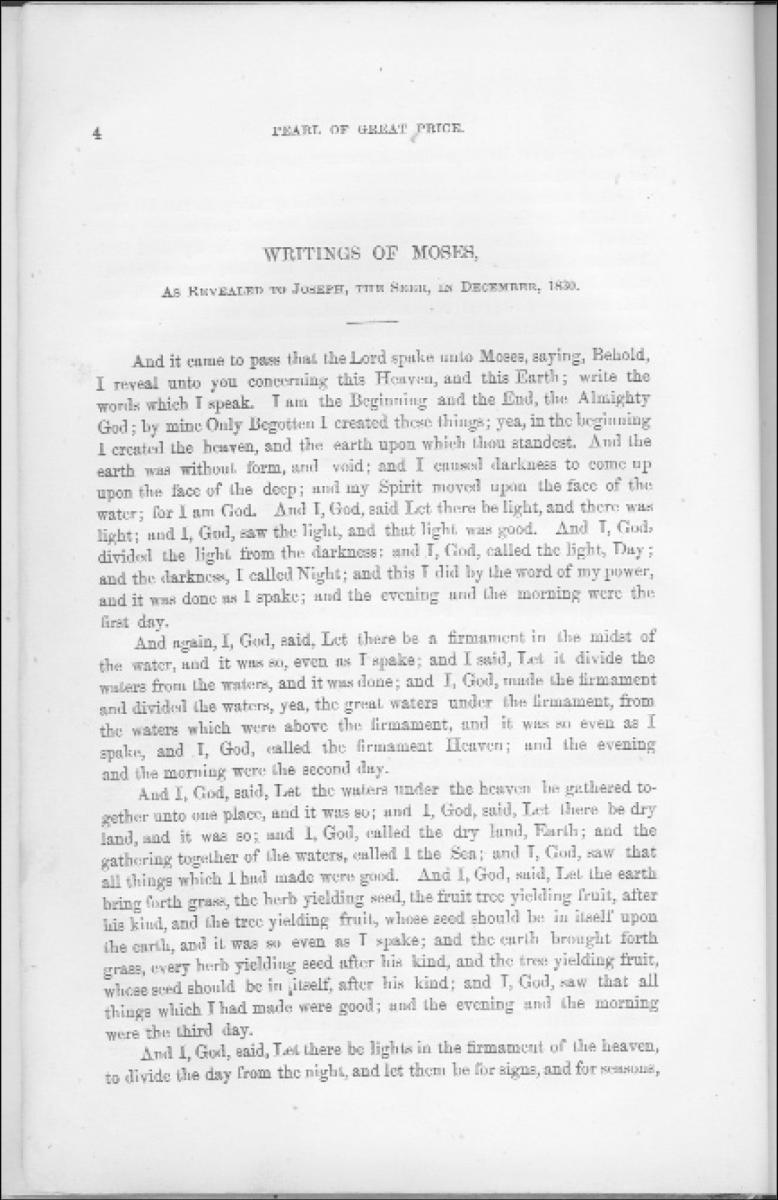 “Writings of Moses,” 1878 Pearl of Great Price, page 4; Moses 2:1–14
“Writings of Moses,” 1878 Pearl of Great Price, page 4; Moses 2:1–14
Early Printings of the Pearl of Great Price
The 1878 edition of the Pearl of Great Price brought the newest standard work of the Church into mainstream Latter-day Saint culture and religious discourse. The Pearl of Great Price has been in print ever since then, and early printings made it immediately inexpensive. In 1879, a year after the new edition came out, the Pearl of Great Price was typeset anew from the 1878 text and printed in Liverpool. The same plates were used again for Liverpool (1882) and Utah (1891) reprints. But the 1879 Book of Moses was not a perfect copy, as these two examples show:[45]
OT1, OT2, 1878: for these many generations, even since the day that I created them (Moses 6:28)
1879: for these many generations, ever since the day that I created them
OT1, OT2, 1878: to gather out mine own elect (Moses 7:62)
1879: to gather out mine elect
An 1888 printing by the Deseret News Company, Salt Lake City, was probably not intended to be a new edition but a new typesetting from the text of the 1878 edition. Even so, its Book of Moses is different in over twenty passages from the 1878 edition, with changes that resulted both from typesetting errors and from apparent editorial decisions. Among the changes that may have been intentional are the following:
OT1, OT2, 1878: there are many worlds which have passed away (Moses 1:35)
1888: there are many worlds that have passed away
OT1, OT2, 1878: the firmament of the heaven (Moses 2:14, 17)
1888: the firmament of heaven
OT1, OT2, 1878: the fourth river was Euphrates (Moses 3:14)
1888: the fourth river was the Euphrates
OT1, OT2, 1878: did eat and gave also unto her husband (Moses 4:12)
1888: did eat and also gave unto her husband
OT1, OT2, 1878: And all the days of Seth were (Moses 6:16)
1888: All the days of Seth were
Changes that appear to be accidental include these:
OT1, OT2, 1878: and a vagabond shalt thou be (Moses 5:37)
1888: and a vagabond shall thou be
OT1, OT2, 1878: his offering thou didst accept (Moses 5:38)
1888: his offering thou didst except
OT1, OT2, 1878: so will I come in the last days, in the days of wickedness (Moses 7:60)
1888: so will I come in the last days of wickedness
In some cases it is not clear whether a change was intentional, as these examples illustrate:
OT1, OT2, 1878: the evening and the morning were the second day (Moses 2:8)
1888: the evening and morning were the second day
OT2, 1878: sware unto him with an oath (Moses 7:51)
1888: sware unto him an oath
OT1, OT2, 1878: mighty men which are like unto them of old (Moses 8:21)
1888: mighty men which are like unto men of old
The 1888 printing of the Book of Moses would be of limited interest historically were it not for the fact that it is a direct ancestor of today’s Book of Moses. Most of its changes were discovered during the preparation of the 1902 edition and were corrected. Only a few continue in today’s Pearl of Great Price.
The 1902 Pearl of Great Price
The 1902 edition of the Pearl of Great Price was not a minor updating but a major revision. The most noticeable features are that it deleted material already found in the Doctrine and Covenants (thus it included only what is in the Pearl of Great Price today),[46] and it contained chapters and verses for the first time. It also added headings and cross-referencing foot-notes. It was in the 1902 edition that the Pearl of Great Price took on most of the form in which we recognize it now. The 1902 edition also gave us a reworked text of the Book of Moses, a text that has not changed significantly since then.
Joseph Smith’s death in 1844 disconnected the Church of Jesus Christ of Latter-day Saints from the New Translation of the Bible. The Prophet was the last Church leader to see the original manuscripts and the only president of the Church ever to be involved in any way with them. No one who worked on the New Translation came west with the Saints,[47] and subsequent Church leaders probably had limited knowledge of it. Over the decades, the absence of information allowed much misunderstanding about the New Translation to make its way into Latter-day Saint culture, a process that would continue into the 1970s. No Latter-day Saint edition of the Book of Moses was prepared with any access to the original JST manuscripts. That placed the Church at a significant disadvantage when it decided to provide a corrected edition in 1902. It is likely that by then, Church leaders had limited knowledge of how our own text of the Book of Moses had been obtained, except in the general understanding that it came from Joseph Smith’s Bible translation. It is likely that few, if any, knew then that the Book of Moses came from the RLDS Inspired Version, and if so, it is likely that no one knew why. Thus when the 1902 edition was prepared, Church leaders did not have a standard against which they could judge the accuracy of the text.
The preparation of the new Pearl of Great Price, including the revised text of the Book of Moses, was assigned to Professor James E. Talmage of the University of Utah.[48] He used as his beginning text a copy of the 1888 printing, which unfortunately was not carefully done and included both typographical errors and other changes. His work on the new edition is documented in his 1888 copy.[49] On its pages he edited the text, writing corrections to errors in the printing and inserting many new wordings. It was from his copy that the compositors set the type for the 1902 edition.[50] A comparison of the available evidence shows the following process at work. In an effort to produce the best text of the Book of Moses possible, Dr. Talmage edited his 1888 copy against earlier printings that he apparently felt were better than what was preserved in the then-current text. Taking in hand the early texts from The Evening and the Morning Star and the Times and Seasons, as well as an 1879 Pearl of Great Price, he edited his text backwards to match many of the wordings in those printings. He had no way of knowing what was on the original manuscripts, and it is likely that he believed that because the newspaper texts were older and were published during the lifetime of Joseph Smith, they contained a more accurate or authoritative text than that used by Elder Orson Pratt in 1878. Probably no one living in Salt Lake City at that time could have known that the 1878 edition was much closer to the words on Joseph Smith’s original documents. In all, Dr. Talmage made about seventy changes that were based on the earlier printings. Following are some examples:
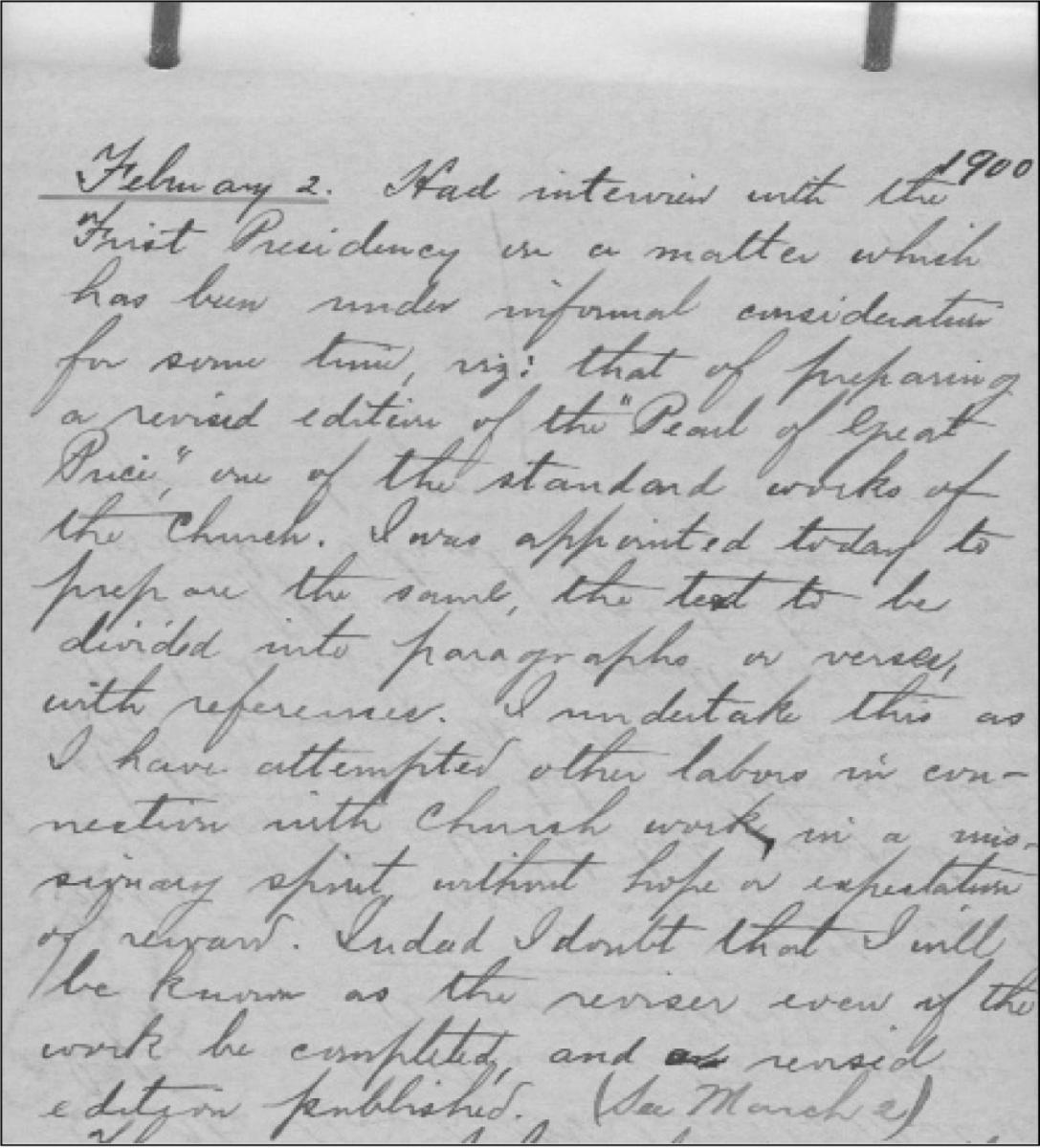 James E. Talmage Journal, February 2, 1900, detail, recording his assignment from the First Presidency to prepare a new edition of the Pearl of Great Price.
James E. Talmage Journal, February 2, 1900, detail, recording his assignment from the First Presidency to prepare a new edition of the Pearl of Great Price.
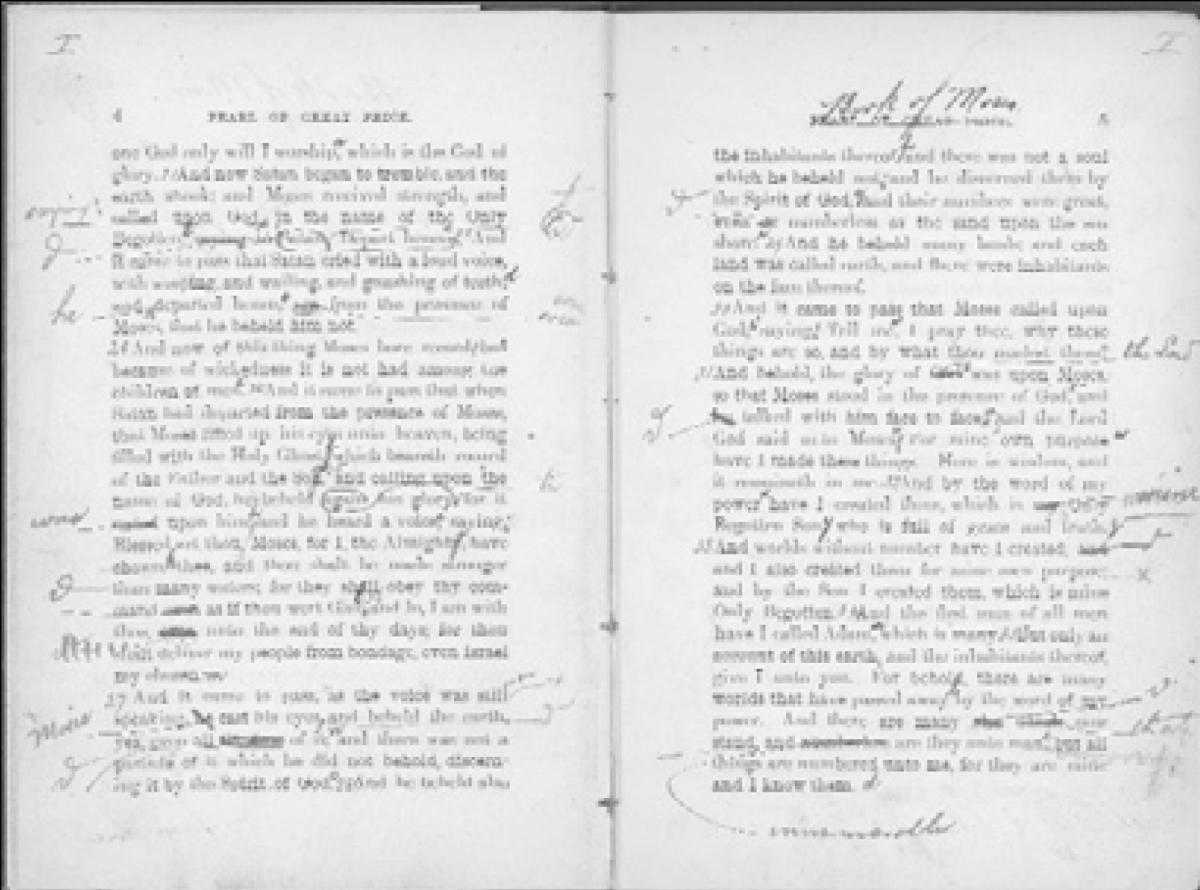 James E. Talmage's 1888 Pearl of Great Price, pages 4-5, showing his editing in preparation for the 1902 edition, including inserted verse numbers and letters for cross-reference footnotes; Moses 1:20-35
James E. Talmage's 1888 Pearl of Great Price, pages 4-5, showing his editing in preparation for the 1902 edition, including inserted verse numbers and letters for cross-reference footnotes; Moses 1:20-35
OT1, OT2: and as Moses beheld the world (Moses 1:8)
TS, 1902: and Moses beheld the world
OT1, OT2: his glory has been upon me, and it is glory unto me, wherefore (Moses 1:18)
TS, 1902: his glory has been upon me, wherefore
OT1, OT2: Depart hence, Satan (Moses 1:20)
TS, 1902: Depart from me, Satan
OT1, OT2: he beheld again his glory, for it rested upon him (Moses 1:25)
TS, 1902: he beheld his glory again, for it was upon him
OT1, OT2: among even as many as shall believe (Moses 1:41)
TS, 1902: among as many as shall believe
OT1, OT2: Go forth to this people (Moses 7:10)
EMS, 1902: Go to this people
OT1: land out of the depths of the sea (Moses 7:14)
EMS, 1902: land out of the depth of the sea
OT2: and thou art there (Moses 7:30)
EMS, 1902: and yet thou art there
OT2: has pled before my face (Moses 7:39)
EMS, 1902: hath plead before my face
OT1: he saw great tribulation (Moses 7:66)
EMS, 1902: he saw great tribulations
In addition to the changes made to match earlier publications of Book of Moses material, Professor Talmage made over thirty revisions that are not based on any previous printing or any known manuscript. A few of those changes correct the grammar or bring the wording more in line with contemporary style:
OT1, OT2, 1878: Behold I, send me (Moses 4:1)
1902: Behold, here am I, send me
OT1, OT2: see thou show them unto no man (Moses 4:32)
1878: see thou showest them unto no man
1902: see thou show them unto no man
OT1, OT2, 1878: the Lord cursed . . . all they that had covenanted with Satan (Moses 5:52)
1902: the Lord cursed . . . all them that had covenanted with Satan
OT1, OT2, 1878: and an Hell have I prepared (Moses 6:29)
1902: and a Hell have I prepared
Most changes show editorial preferences that differ from the wording Joseph Smith dictated to his scribes:
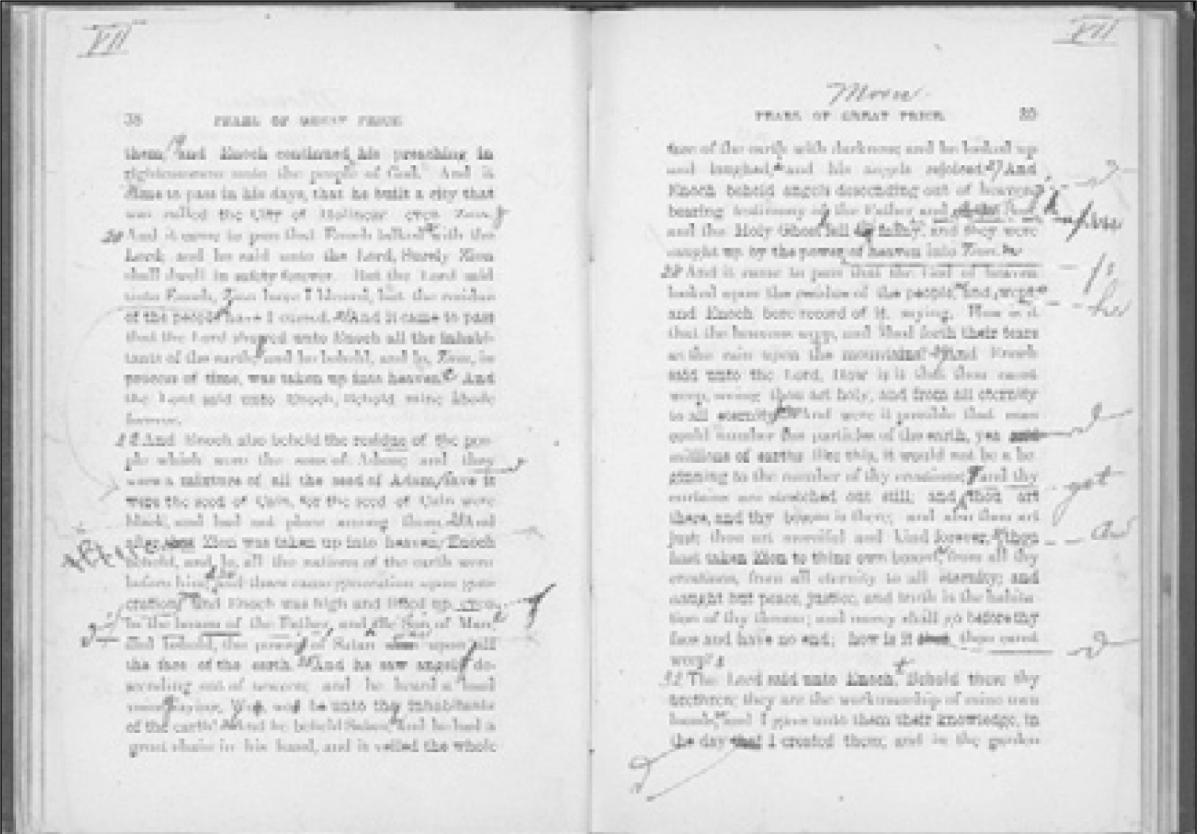 James E. Talmage’s 1888 Pearl of Great Price, pages 38–39, showing his editing in preparation for the 1902 edition, including inserted verse numbers and letters for cross-reference footnotes; Moses 7:18–32
James E. Talmage’s 1888 Pearl of Great Price, pages 38–39, showing his editing in preparation for the 1902 edition, including inserted verse numbers and letters for cross-reference footnotes; Moses 7:18–32
OT2, 1878: and beheld the earth, yea, even all the face of it (Moses 1:27)
1902: and beheld the earth, yea, even all of it
OT1, OT2, 1878: the glory of God was upon Moses (Moses 1:31)
1902: the glory of the Lord was upon Moses
OT1, OT2, 1878: Adam called upon the name of the Lord, and Eve also, his wife (Moses 5:4)
1902: Adam and Eve, his wife, called upon the name of the Lord
OT1, 1878: yea and millions of earths (Moses 7:30)
1902: yea millions of earths
OT1, OT2, 1878: How is it that thou canst weep? (Moses 7:31)
1902: How is it thou canst weep?
OT1, OT2, 1878: and Enoch saw Noah, also, and his family (Moses 7:42)
1902: and Enoch also saw Noah, and his family
OT1, OT2, 1878: And as Enoch saw thus, he had bitterness of soul (Moses 7:44)
1902: And as Enoch saw this, he had bitterness of soul
OT1, 1878: For inasmuch as (Moses 7:59)
1902: Forasmuch as
OT1, OT2, 1878: for the space of a thousand years shall the earth rest (Moses 7:64)
1902: for the space of a thousand years the earth shall rest
OT1, OT2, 1878: the sons of men saw that their daughters were fair (Moses 8:14)
1902: the sons of men saw that those daughters were fair
OT1, OT2, 1878: even as our fathers did, and ye shall (Moses 8:24)
1902: even as our fathers, and ye shall
A few changes in the 1902 edition were not written by Dr. Talmage in his copy of the Pearl of Great Price and are not based on any earlier manuscript or printing. These may have resulted from insertions he or others made in the printer’s proofs, but more likely they are errors made by a typesetter.
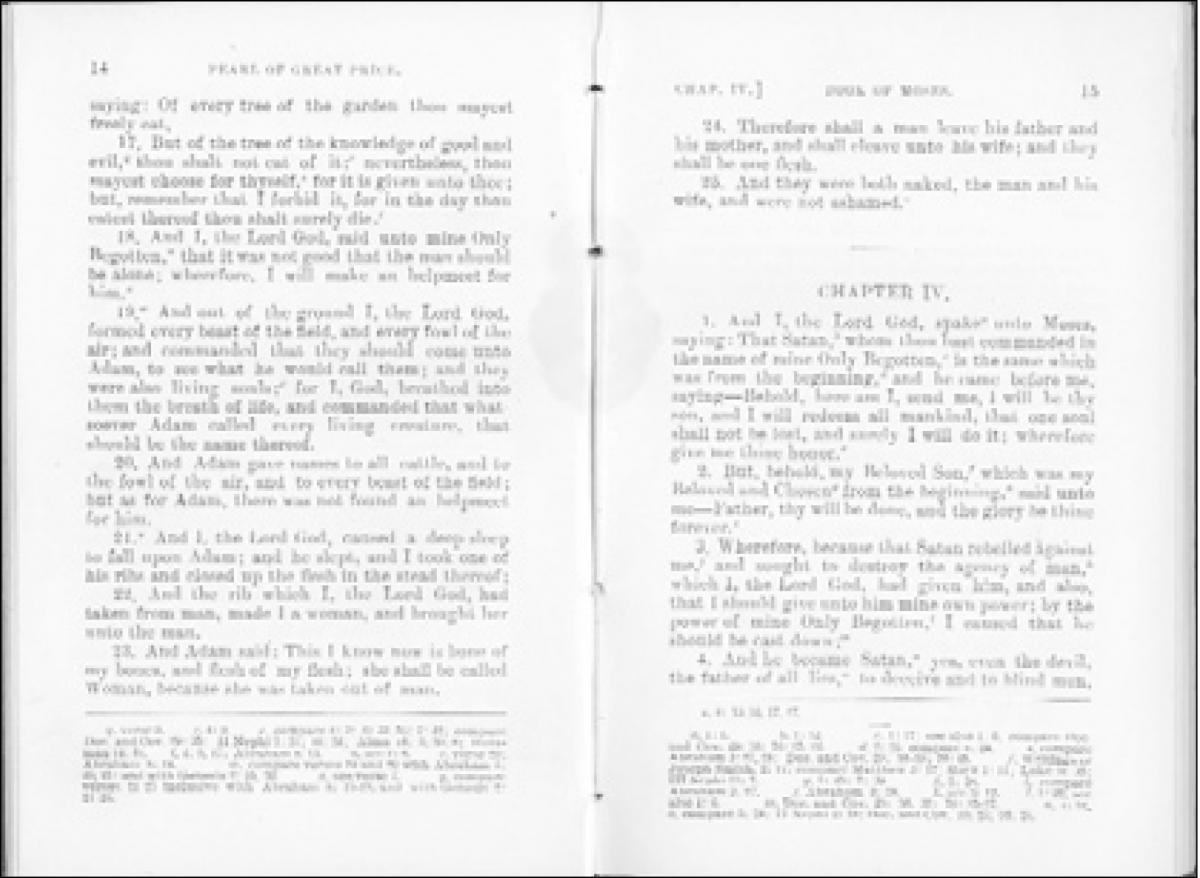 1902 Pearl of Great Price, pages 14-15; Moses 3:16--4:4
1902 Pearl of Great Price, pages 14-15; Moses 3:16--4:4
OT2, 1878: where I, the Lord, created much gold (Moses 3:11)
1902: where I, the Lord God, created much gold
OT1, 1878: sent forth in the world, unto the end thereof (Moses 6:30)
1902: sent forth in the world, unto the ends thereof
OT2, 1878: the filthiness which has gone forth out of me (Moses 7:48)
1902: the filthiness which is gone forth out of me
The punctuation of the 1902 Book of Moses generally follows that of the 1888 printing. But there are some differences, many of which were caused by the insertion of verse breaks. The 1921 and 1981 editions follow the 1902 punctuation virtually without change.[51]
The 1921 and 1981 Pearl of Great Price
The 1921 edition of the Pearl of Great Price was prepared under the direction of a committee of members of the Quorum of the Twelve Apostles, including Elder James E. Talmage.[52] The most visible change in that edition was the two-column format, which had been the norm in Bible printings for centuries and was now adopted in the Pearl of Great Price. The text of the Book of Moses underwent only small changes. Most of the changes were orthographic or typographical and had little bearing on the choice or meaning of words, as these examples show:
1902: I will make an helpmeet for him (Moses 3:18, 20)
1921: I will make an help meet for him
1902: and they sewed fig leaves together (Moses 4:13)
1921: and they sewed fig-leaves together
1902: henceforth and for ever (Moses 5:9; 6:66)
1921: henceforth and forever
One change corrects an error from the 1902 edition:
1902: and they were despised among all people (Moses 7:8)
1921: that they were despised among all people
The 1981 Pearl of Great Price is the one used in the Church today. It was part of an extensive project that produced new editions of all the scriptures, including a new Latter-day Saint Bible edition published in 1979. New editions of the Book of Mormon, the Doctrine and Covenants, and the Pearl of Great Price were published together in 1981.[53] In addition to new footnotes and headings, the new Pearl of Great Price included small changes to the text. In the Book of Moses, only four changes were made in the wording. An error was corrected that had entered the Pearl of Great Price in 1902, having been copied from the 1843 Times and Seasons printing:
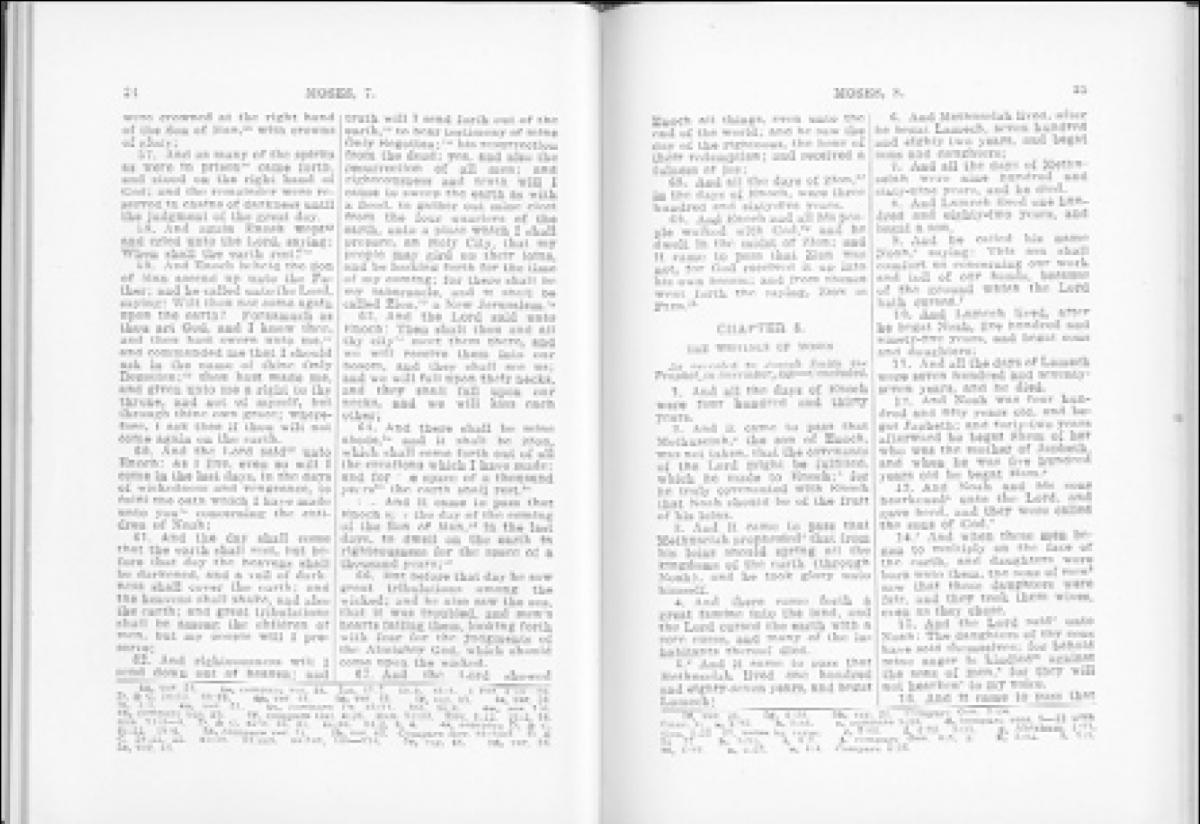 1921 Pearl of Great Price, pages 24-25; Moses 7:56-8:16
1921 Pearl of Great Price, pages 24-25; Moses 7:56-8:16
OT1, OT2: transfigured before him (Moses 1:14)
TS, 1902, 1921: strengthened before him
1981: transfigured before him
The 1981 edition dealt with an enigmatic word in Moses 1:19. Oliver Cowdery wrote Joseph Smith’s dictation as follows: “Satan cried with a loud voice and wrent upon the earth.” The words were copied identically on OT2 by John Whitmer, but Whitmer wrote “rent” on another copy that he made of the manuscript.[54] Wrent is likely a regional spelling of rent, the past tense of rend, “to tear.” Satan “tore upon the earth.” In the Printer’s Manuscript of the Book of Mormon, copied by Oliver Cowdery from the Original Manuscript, the word wrent is found at Alma 14:27, “the walls of the prison were wrent in twain,” and at 3 Nephi 8:18, “the rocks were wrent in twain.”[55] In the 1830 Book of Mormon, the spelling of the first of these remained “wrent,” but the spelling of the second was standardized to “rent.” Wrent also appears elsewhere in the Joseph Smith Translation, as a noun at Mark 2:21, “the wrent is made worse.”[56] John Whitmer was the scribe for that section.[57] In the RLDS Committee Manuscript at Moses 1:19, Joseph Smith III’s handwriting is not clear, but it appears that he wrote “went” rather than “wrent,” probably following the reading in the Times and Seasons. The typesetter clearly saw “went” and rendered the word thus in the 1867 Inspired Version. Elder Orson Pratt changed it back to “rent” in the 1878 Pearl of Great Price, and so it remained until the 1981 edition, when it was changed to “ranted.”[58]
 1981 Pearl of Great Price, pages 10-11; Moses 4:14-5:9
1981 Pearl of Great Price, pages 10-11; Moses 4:14-5:9
OT1, OT2: Satan cried with a loud voice and wrent upon the earth (Moses 1:19)
TS, CM, IV: Satan cried with a loud voice and went upon the earth
1878, 1902, 1921: Satan cried with a loud voice and rent upon the earth
1981: Satan cried with a loud voice and ranted upon the Nearth
At Moses 4:18, the 1981 edition of the Pearl of Great Price changes the tense of one word:
OT1: thou . . . commanded that she should (Moses 4:18)
1878, 1902, 1921: thou . . . commandedst that she should
1981: thou . . . commandest that she should
The deletion of the second letter d avoids a difficult consonant cluster, yet it changes the tense of the clause from the past to the present. The final word change in the 1981 Book of Moses revises the phrase “save it were” to “save it was” (Moses 7:22). The phrase “save it were”— meaning “except for”—appears seventy-six times in the Book of Mormon, once in the Doctrine and Covenants (see D&C 18:35), and once elsewhere ten verses earlier in the Book of Moses (see Moses 7:12).[59]
OT1, OT2: save it were (Moses 7:22)
1878, 1902, 1921: save it were
1981: save it was
The 1981 edition also moves the verse break between Moses 5:52 and 5:53. The sentence “And it was among the sons of men” began verse 53 in the 1902 and 1921 editions. In the 1981 edition, it was placed at the end of verse 52.
Notes
[1] Transcriptions of the original manuscript pages, with introductory essays, are presented in Scott H. Faulring, Kent P. Jackson, and Robert J. Matthews, eds., Joseph Smith’s New Translation of the Bible: Original Manuscripts (Provo, UT: Religious Studies Center, Brigham Young University, 2004). All citations from original manuscripts are from that source.
[2] The title “Book of Moses” was first added in 1902. In 1981 the title was made more precise with “Selections from the Book of Moses.” For convenience, I will follow the common practice and use “Book of Moses” even in contexts that predate the application of that name in 1902.
[3] Franklin D. Richards, The Pearl of Great Price: Being a Choice Selection from the Revelations, Translations, and Narrations of Joseph Smith, First Prophet, Seer, and Revelator to the Church of Jesus Christ of Latter-day Saints (Liverpool: F. D. Richards, 1851), title page.
[4] The 1851 Pearl of Great Price included the following items: the JST through Genesis 6:13 (now Selections from the Book of Moses), Matthew 23:39–24:51 from the JST (Joseph Smith—Matthew), the Book of Abraham, parts of five sections from the Doctrine and Covenants (no longer included), part of the Prophet’s 1838 history (Joseph Smith—History), the Articles of Faith (not known by that title at the time), and a poem entitled “Truth” (now hymn 272 in the LDS hymnbook).
[5] The name foolscap derived from paper in the eighteenth century that bore the watermark of a fool’s cap.
[6] OT1 is housed in the Library-Archives of the Community of Christ in Independence, Missouri. In some older publications, this document is titled “Old Testament Manuscript 2,” based on a misunderstanding by early archivists regarding the sequence of the New Translation.
[7] See Joseph Smith, The Papers of Joseph Smith: Vol. 1, Autobiographical and Historical Writings, ed. Dean C. Jessee (Salt Lake City: Deseret Book, 1989), 324–25; D&C 28:8–10.
[8] See OT1, pages 11, 12, and 19.
[9] See OT1, page 7.
[10] OT2 is housed in the Library-Archives of the Community of Christ in Independence, Missouri. In some older publications, it is titled “Old Testament Manuscript 3.”
[11] See OT1, page 61.
[12] The end date of the Old Testament and thus of the entire Joseph Smith Translation is noted at the end of Malachi: “Finished on the 2d day of July 1833” (OT2, page 119).
[13] For example, OT2, page 8, lines 14 and 16; see also Genesis 3:2–5.
[14] In some examples cited below, spelling or punctuation or both have been standardized for clarification.
[15] See Robert J. Matthews, “Joseph Smith’s Efforts to Publish His Bible Translation,” Ensign, January 1983, 57–64.
[16] This manuscript was preserved by the family of David Whitmer and acquired by the Reorganized Church of Jesus Christ of Latter Day Saints in 1903. It is housed in the Library-Archives of the Community of Christ in Independence, Missouri, and is catalogued as Old Testament Manuscript 3. In some older publications it was called “Old Testament Manuscript 1.”
[17] The Edward Partridge manuscript is housed in the Church Archives, the Church of Jesus Christ of Latter-day Saints, Salt Lake City, Utah.
[18] See The Evening and the Morning Star 1, no. 3 (August 1832): 2–3.
[19] See The Evening and the Morning Star 1, no. 10 (March 1833): 1.
[20] See The Evening and the Morning Star 1, no. 11 (April 1833): 1–2.
[21] See “Lecture Second,” Doctrine and Covenants of the Church of the Latter Day Saints (Kirtland, OH: F. G. Williams and Co., 1835), 13–18. It contained the following passages from the Book of Moses: Moses 2:26–29; 3:15–17, 19–20; 4:14–19, 22–25; 5:1, 4–9, 19–23, 32–40.
[22] See “History of Joseph Smith,” Times and Seasons 4, no. 5 (January 16, 1843): 71–73.
[23] For the Bernhisel manuscript, see Robert J. Matthews, “A Plainer Translation”: Joseph Smith’s Translation of the Bible—A History and Commentary (Provo, UT: Brigham Young University Press, 1975), 117–40. The manuscript is housed in the Church Archives, the Church of Jesus Christ of Latter-day Saints, Salt Lake City, Utah.
[24] Moses 6:43–7:69.
[25] Moses 1:1–4:19, 22–25; 5:1–16, 19–23, 32–40; 8:13–30.
[26] See The Latter-Day Saints’ Millennial Star 13, no. 6 (March 15, 1851): 90–93.
[27] The Pearl of Great Price, 1851, vi.
[28] The Holy Scriptures, Translated and Corrected by the Spirit of Revelation. By Joseph Smith, Jr., the Seer. (Plano, IL: The [Reorganized] Church of Jesus Christ of Latter- Day Saints, 1867). For convenience, I will refer to it as the “Inspired Version,” even though it did not receive that title until later.
[29] The story of the preparation and publication of the 1867 Inspired Version is summarized in Matthews, “A Plainer Translation,” 141–69, and in Richard P. Howard, Restoration Scriptures: A Study of Their Textual Development, rev. and enl. (Independence, MO: Herald, 1995), 111–18.
[30] The True Latter Day Saints’ Herald 9, no. 8 (April 15, 1866): 125.
[31] The 1866–67 Committee Manuscript is housed in the Library-Archives, Community of Christ, Independence, Missouri.
[32] The first few pages of the manuscript are in the handwriting of Joseph Smith III, who apparently recopied them after editing Faulconer’s manuscript pages.
[33] See Mary Audentia Smith Anderson, ed., “The Memoirs of President Joseph Smith (1832–1914),” Saints’ Herald 82, no. 26 (June 25, 1935): 818.
[34] Probably for the same reasons, the 1851 Pearl of Great Price had already made the same grammatical corrections in Moses 4:6 and 5:11.
[35] The OT2 verse divisions are evident in the Bernhisel Manuscript, which was copied from OT2 in the summer of 1845. The evidence for punctuation and capitalization is less clear. Bernhisel did not include the OT2 punctuation or capitalization insertions, so perhaps they were not yet on the manuscript. But he also did not capitalize all the words that the original scribes capitalized, and he may have simply ignored all but verse-ending punctuation.
[36] For example, OT2, page 16, line 7 from bottom (“ye”).
[37] For example, OT2, page 23, lines 13 (“looked”) and 28 (“filthiness”).
[38] See “Memoirs of President Joseph Smith,” 818.
[39] See Matthews, “A Plainer Translation,” 167–205. Matthews identified 352 verses in the 1944 edition that differ from the 1867 edition; Matthews, “A Plainer Translation,” 173, 179–89, 427–34. See also Howard, Restoration Scriptures, 119–27.
[40] “Minor errors, mainly involving typography and punctuation.” 1991 Inspired Version, “Foreword to the 1991 Edition,” [6].
[41] See Howard, Restoration Scriptures, 172, 177 n. 24.
[42] “Because of space considerations only, it is not reprinted here.” 1991 Inspired Version, “Foreword to the 1991 Edition,” [7].
[43] Pages 7–9, 11–26.
[44] See Deseret Evening News, October 11, 1880, 2.
[45] Both of these changes would later be adopted into the 1902 Pearl of Great Price.
[46] The poem “Truth” was deleted also.
[47] Joseph Smith (died 1844), Oliver Cowdery (excommunicated 1838, died in the Church 1850), John Whitmer (excommunicated 1838), Emma Smith (did not go west), Sidney Rigdon (excommunicated 1844), and Frederick G. Williams (excommunicated 1839, died in the Church 1842).
[48] See title page, 1902 Pearl of Great Price; Conference Report, October 1902, 83; James E. Talmage Journal, February 2, 1900 (vol. 10, page 327), L. Tom Perry Special Collections, Harold B. Lee Library, Brigham Young University, Provo, Utah.
[49] James E. Talmage’s 1888 Pearl of Great Price is housed in the L. Tom Perry Special Collections, Harold B. Lee Library, Brigham Young University.
[50] A second, identical copy is also housed in the L. Tom Perry Special Collections. It contains Talmage’s notations for the cross-reference footnotes of the 1902 edition.
[51] We do not know what Dr. Talmage’s instructions were for the 1902 Book of Moses. His journal mentions his work on the new edition and related meetings on several occasions, but with little detail. Almost all of the changes made in the 1902 edition remain in the Book of Moses today. In the October 1902 general conference, President Joseph F. Smith presented the newly published edition of the Pearl of Great Price for a sustaining vote, and it was reaffirmed in its place as one of the standard works of the Church. President Smith stated: “I hold in my hand a copy of the revised edition of the Pearl of Great Price. The Pearl of Great Price, as it originally existed, was presented before the general conference and accepted as one of the standard works of the Church. Since then the book has undergone a revision; that is to say, all the revelations that it formerly contained which were also in the Book of Doctrine and Covenants, have been eliminated from it. . . . In addition to this, Professor James E. Talmage has gone through the work and divided it into chapters and verses, making it a far more convenient book of reference than it was before. He has also supplied copious footnotes or references, which will be an aid in the study of the book. These are the changes that have been made in the book, and we now present this book in its revised form—the original matter being preserved as it was before, only divided into chapters and verses—for your acceptance as a standard work of the Church” (Conference Report, October 1902, 83; see also James E. Talmage Journal, October 6, 1902 [vol. 10, page 471], L. Tom Perry Special Collections).
[52] Elder Talmage was called to the Quorum of the Twelve Apostles in December 1911.
[53] See Robert J. Matthews, “The New Publications of the Standard Works—1979, 1981,” BYU Studies 22, no. 4 (Fall 1982): 387–423.
[54] Old Testament Manuscript 3, page 1, line 44.
[55] Royal Skousen, ed., The Printer’s Manuscript of the Book of Mormon: Typographical Facsimile of the Entire Text in Two Parts (Provo, UT: Foundation for Ancient Research and Mormon Studies, Brigham Young University, 2001), 462, 804. The Original Manuscript pages containing these passage are no longer extant.
[56] New Testament Manuscript 2, Folio 2, page 12, line 2.
[57] I thank Robert J. Matthews for bringing these uses of the word wrent to my attention.
[58] Noah Webster’s 1828 dictionary cites a source that uses rent (present tense) as a verb with the meaning “rant”; An American Dictionary of the English Language (New York: S. Converse, 1828), s.v. “rent.”
[59] The related phrase “save it be” appears in the Book of Mormon forty-seven times (for example, 2 Nephi 2:8) and nine times in the Doctrine and Covenants (for example, D&C 18:20).
